Archives of The Future Alternative Past
Future Alternative Past: Religion. Seriously.
Every month, Nisi Shawl presents us with news and updates from her perch overlooking the world of science-fiction, fantasy, and horror. You can also look through the archives of the column.
I teach writing classes. One thing I ask my students to do is fill in a spreadsheet for their work-in-progress’s characters, noting race, age, sexual orientation, so forth, so on. And the category of character traits they usually haven’t thought about before is religion. Or the absence of it. Which is weird.
The default religious status in this time and place is a vaguely Protestant-ish Christianity. But SFFH authors aren’t necessarily working in the here and now. Post-apocalyptic landscapes may be the breeding grounds for a warped Catholicism such as that pervading Walter M Miller, Jr.’s 1959 classic A Canticle for Leibowitz. In Canticle, monks preserve scientific knowledge through a new Dark Age. The lives of religious institutions are protracted compared to human lifespans, so they can easily perform this sort of centuries-long service, as Octavia E. Butler has the heroine of Parable of the Sower realize. So Butler’s pragmatic Lauren Oya Olamina devises her own religion, “Earthseed,” as a means of guiding future generations to the stars.
In Daniel José Older’s dark fantasy Half-Resurrection Blues, Santeria, an Afro-Latin spiritual tradition, colors the half-dead hero’s interactions and grounds his world. In the new novel Tentacle, Rita Indiana writes explicitly of Santeria’s Dominican version, pitting a poor trans man newly initiated into the mysteries of the ocean deity against coral bleaching and mass fish die-offs. This tradition is my own, and it appears in several of my stories, too, most notably in “Wallamelon,” in which a young woman learns how to divine.
What about atheism? Anti-religious SFFH writing seems far more prevalent than straightforwardly atheist plots and themes. The God in Phillip Pullman’s His Dark Materials series is tyrannical and vulnerable, and killing him is an act of heroism. However, he does exist. In “The Old Rugged Cross” by Terry Bisson, collected in Greetings and Other Stories, condemned convict Bud White’s vision of Jesus is very likely a hallucination, but it’s not explicitly so. Better cases can be made for Kim Stanley Robinson’s novel Galileo’s Dream and Arthur C Clarke’s Hugo Award-winning short story “The Star,” since in both the antagonist is a belief system rather than a deity.
Sometimes encounters with religion are the point of a piece of SF, as in The Sparrow or Behold the Man or “The Tower of Babylon.” Generally, though, the topic is simply not mentioned. Typical SF backdrops are big on vague secularisms, which can be interpreted any number of ways — including as the casual Christianity most US readers identify as their own.
In the case of fantasy and horror, there are almost always clearer delineations of characters’ spiritual practices and beliefs. Not everyone in a given story is a practitioner, though — which is as it should be. But what the exercise I mentioned at this column’s beginning is meant to provoke, what I’d like to see, is more thought, more care and consideration given to why and how and what each and every single one of them believes. Or doesn’t. Schisms, doubts — they’re part of the human experience. Maybe the transhuman experience, too. Help me find out.
Recent books recently read

MR Carey’s novel The Girl with All the Gifts won my heart and mind completely with its outrageous child-zombie viewpoint. To a slightly lesser extent I also dug Fellside, a later novel which was in no way related. Carey’s new book, Someone Like Me (Orbit), shares themes and focus with Fellside — identity, bodilessness, sanity, violence — but packs as much punch as Girl. Hapless Liz Kendall, self-blaming victim of a series of domestic beatdowns, finds herself host to an alternate personality who has studied her abuser through thousands of parallel worlds and knows just how to fight back. Liz’s sometimes irksome moments of passivity are nicely balanced by the activeness of her co-protagonist, feisty Fran Watts, and the unswerving bravery of Fran’s putatively imaginary friend Jinx. As Carey shares the details of how teenaged Fran confronts the kidnapper who shattered her life when she was only nine, and Liz learns crucial survival skills, he evokes the shivery desolation haunting the most mundane landscapes. At the book’s beginning love and geography link Liz and Fran’s storylines; by the end they’re inextricably dependent on one another for a gut-wrenching, teeth-gritting climax.

If you’d asked me when I first read Fahrenheit 451 which book I would want to emulate its dystopia-dwelling characters by memorizing, my unhesitating answer would have been The Last Unicorn. Author Peter S Beagle has written many wonderful books since then, but his latest returns to this favorite of mine, which is also the favorite of millions of others. The Last Unicorn: The Lost Journey (Tachyon) opens with the full book’s immortal opening lines:
The unicorn lived in a lilac wood, and she lived all alone. She was very old, though she did not know it, and she was no longer the careless color of seafoam, but rather the color of snow falling on a moonlit night.
In addition to poetry and mystery, there’s humor and contrarity in The Last Unicorn, and Journey includes plenty of both — especially in the person of a new character, a two-headed demon named Azazel. Stephanie Law’s charming interior illustrations and the author’s reminiscences on the story’s 1962 genesis round out what could have been an unsatisfyingly thin publication; the story stops rather than concluding, but Beagle’s many admirers will gratefully accept these fresh fragments of his most entrancing tale. And I can add their recitation to my post-apocalyptic repertoire.
Couple of upcoming cons
The website for Imagicon is almost entirely in Dutch. I can’t read it, but I guess most potential attendees are going to be fine, since this event takes place in the Netherlands. Judging from photos and loan words, there will be a boatload of cosplay there, including a cosplay dating game. Also films, workshops, gaming, and panels — with one on strong females and the Ghostbusters sequel. In Dutch.
Though I’m not one of their Guests of Honor this year, I hear that Confusion is still the hip, happenin place to be. Its suburban Detroit location isn’t smack dab in the continent’s middle, but it’s close enough. And an impressive array of the emergent and bodacious shows up there: John Chu, Margaret Killjoy, Maurice Broaddus, and Monica Valentinelli, to name a few. Cheap and thrilling and convenient, this is a convention to take sweet advantage of.
Future Alternative Past: Vegetable love
Every month, Nisi Shawl presents us with news and updates from her perch overlooking the world of science-fiction, fantasy, and horror. You can also look through the archives of the column.
We’re mammals. Beasts. But when we look at the world we inhabit, we see ourselves surrounded by plant life, and when we look at that world through the lens of SFFH we can see the plants surrounding us as neighbors and potential rivals.
Fantasy is full of dryads, mythological tree spirits I first became acquainted with via CS Lewis’s Chronicles of Narnia. Though Lewis’s series is famously a Christian allegory, clues to the books’ religious core escaped me, and this may be due to my fascination with its pagan façade. Narnian dryads died when their trees were chopped down, and I developed a fierce protectiveness for the saplings in the vacant lot next to my childhood home.
But did they need my protection? Sneaking under the fence to watch movies at the drive-in on the far side of the ballpark across the street, I was introduced to Nathaniel Hawthorne’s short horror story “Rappaccini’s Daughter.” This 19th century tale of a toxic garden centers on a luridly beautiful tree bearing fatal flowers. Its breath is death — except to the young woman who tends it, who is in some way its sister. The woman’s exhalations bring death, too, to those who come too close. Her touch could kill the student who courts her, instantly; thorns and poisons are plants’ primary defenses, and far more potent than the wrath of a grade-school girl.
Science fictional instances of botanic speculation include several wistful references to human photosynthesis. There’s 2011’s By Light Alone, by Adam Roberts, with its ironic take on conspicuous oral consumption; earlier, there are the symbs of John Varley’s Eight Worlds series, symbiotic human/plant partnerships that allow us to live indefinitely in the vacuum of space — as long as said vacuum is sunlit. Ursula K Le Guin often celebrated our interrelatedness, most notably in her 1972 novel The Word for World Is Forest. In my short story “Slippernet” I invoke the power of forests’ mycorrhizal networks or “Wood Wide Web” as empathy-injectors disabling Trumpian othering, and I’ll be doing more with these fungal threads in my upcoming sequel to Everfair.
But by far the most interesting sfnal exploration of straight up plant intelligence is Sue Burke’s novel Semiosis. Set onan extrasolar colony, the book begins with a wincingly plausible cascade of mini-disasters culminating in a tense situation which only partnership with an herb-based sentience can resolve. Kim Stanley Robinson’s Aurora highlights the futility of classifying extraterrestrial life along an Earth-context plant-animal binary, which even locally falls apart (slime molds, anyone?). And yet, drawing on recent scientific discoveries, Burke does a tremendous job of showing us the thought processes of an actual vegetable. In doing this she moves a step beyond the scope of Le Guin’s 1971 short story “Vaster than Empires and More Slow,” writing some passages from the viewpoint of her alien character’s widely distributed and practically immortal mind.
Recent books recently read

My Writing the Other co-author Cynthia Ward’s latest pulptastic vampire novella, The Adventure of the Dux Bellorum (Aqueduct Press), pits Dracula’s queer daughter against a mad scientist in Kaiser Wilhelm’s pay. The daughter, Lucy Harker, is a British spy assigned to keep the titular “dux bellorum” — aka “warlord” — Lieutenant-Colonel Winston Churchill out of trouble during his tour of duty on the Great War’s Western Front. Since that includes battling mind-controlled wolfmen and giant telepathic pterodactyls, this is a pretty tall order. Fortunately Harker’s lover, another lesbian vampire, happens to be a British spy as well. Together the couple fight the good gonzo fight for Truth, Justice, and the Triumph of Democracy. Throughout their sensationalistic escapades Ward references the works of HG Wells, Arthur Conan Doyle, MR James, and other forefathers of SFFH with wholehearted enthusiasm, yet still manages to update their stodginess with breathtakingly matter-of-course feminism and homophilia. Which is to say this is nostalgia for forward-looking readers. A neat trick. Also a fun one.

Swedish author John Lindqvist’s debut novel Let the Right One In caused an international stir, blending traditional vampire lore with modern social issues such as bullying and gender fluidity. I Am Behind You is the English translation of Himmelstrand, a later and decidedly weirder work of Lindqvist’s, a novel which only hints as to what befalls its characters. Explanations are apparently being left for the two following volumes of this trilogy; what we have in the first book is the set-up, plus a bit of nasty description and some character development.
The set-up: four RVs are mysteriously transported with their contents and inhabitants to a strange, grassy field beneath a sunless blue sky. The viewpoint characters include two kids, four couples, and a beagle. Most of the nastiness boils down to an attacking horde of whimpering zombies and a powerfully acid rainfall, though there’s also plenty of old fashioned gore: spilled blood, oozing guts...the proper balance of ick and wtf, in sum, to begin a long and hopefully disturbing new saga of loneliness and horror.
Couple of upcoming cons
Con+Alt+Delete is an anime convention you’ll want to attend if you like “Full metal Alchemist, Dragon Ball Z, Yu-Gi-Oh, Lolita Fashion, Homestuck, My Little Pony,” and similar sorts of entertainment. Or maybe you ought to go if you want to get your cosplay on — there will be competitions.
For those who prefer something a bit more specialized there’s Tacoma’s Weekend of Wizardry, which basically promises live-action Harry Potter fanfic. It sounds especially tempting to those of us still awaiting the arrivals of our owls.
Future Alternative Past: Talking Trash
Every month, Nisi Shawl presents us with news and updates from her perch overlooking the world of science-fiction, fantasy, and horror. You can also look through the archives of the column.
A couple of weeks ago, my mother died, suddenly and unexpectedly. Through a fog of grief, I’ve been handling clearing out her apartment; this includes sorting through the material remnants of her life and categorizing them as merchandise versus donations versus garbage. Which is why I’m now thinking about trash in speculative fiction.
It’s a truism that SFFH interrogates basic concepts such as the defining boundaries of consciousness. Also, though, it addresses more mundane issues. Like, what’s garbage? What’s salvage? How can you transform one into the other? And how do the answers to these sorts of questions affect the fictional worlds in which they’re asked?
Inside spaceships and artificial habitats, recycling holds pride of place. Such closed systems must reuse their components indefinitely, breaking them down and reconstituting them ad infinitum. Though I can’t recall which specific stories I first read dealing with this idea (see “fog of grief” above), it’s deeply enough engrained in me that I automatically incorporate it into my own work. “Maggies,” for instance, which first appeared in the second volume of the groundbreaking Dark Matter anthology series, takes place in an off planet underwater terraforming station; in a casual aside I describe a character tossing napkins “into the paper cycler.”
In Dune the fremen of Frank Herbert’s desert planet Arrakis wear “stillsuits,” specially engineered unitards which capture and recycle water normally released via feces, urine, sweat, and exhaled vapors.
William Tenn’s famous “Down among the Dead Men” pushes the conceit of recycling human resources nastily further, positing a future government which not only reclaims used fuels and minerals but reanimates dead soldiers and sends them back into military service.
Nearer to imminent realization is the premise of Ray Bradbury’s 1953 short story “The Garbage Collector,” in which an ordinary man rebels against prosaically horrible instructions for retrieving dead bodies in the event of a nuclear attack. Seattle author Nicola Griffith’s Nebula and Lambda award-winning novel Slow River also hews more closely to current possibilities in its sfnal take on the technology of pollution remediation.
Samuel R. Delany’s Empire Star delivers a bit of Darko Survin's “cognitive estrangement” by showing its characters’ bemusement at our culture’s revulsive reaction to shit — even unto a taboo against talking about it. As one tells another, “food once eaten and passed from the body could not be spoken of by its common name in polite company.” Fantasy sometimes does the opposite, replicating attitudes like these to create bridges between readers and its imaginary worlds. Robert Jackson Bennett’s Foundryside depicts super thief Sancia Grado predictably sneaking toward her target through sewers — but then not-so-predictably, though logically, alerting foes to her presence due to the powerful odor with which said sewers imbue her.
A few SFFH films come to mind, too, touching on this topic. The notorious trash compactor scene in Star Wars: A New Hope ignores the waste-not-want-not ethos mentioned earlier, with our heroes wading ankle deep through smelly chunks of grunge floating in a nameless liquid noxiousness from which the precious water has clearly not been extracted. The outpost dwellers in Kenyan filmmaker Wanuri Kahiu’s short Pumzi deal with their waste very simply, by ejecting it from their doors into the surrounding desert. They do go to great lengths to conserve water, though. And then there’s WALL-E, the 2008 animated movie about a robot trying to clean up an entire planet’s worth of trash. Which we must hope is a completely implausible extrapolation from the worst take on our contemporary garbage-or-not conundrum.
Recent books recently read
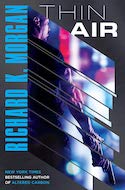
Richard K. Morgan’s new cybernoir novel Thin Air (Del Rey) is fat with all kinds of goodness. There’s the exploding-heads-and-voiding-guts sort, the expected excitement of balletic violence depicted with flair, even grace. But there’s also the novel’s wonderfully respectful treatment of its women characters.
With Thin Air’s relentlessly fast action unfolding on a halfway settled Mars only gradually easing back from its frontier attitudes, this is saying something. But though narrator Hakan Veil is a genetically enhanced male, a corporate enforcer permanently stranded far from the green hills of Earth; and though he does plenty of digging to find out how and why mysterious killers are aiming at him, it’s the book’s women who make the crucial difference in this battle between good and evil. The whore next door, the beat-weary detective, the cynical heir of a revolution — all act according to their particular priorities and so further a plot in which more than one gender holds up the paprika-colored Martian sky.
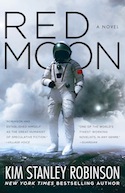
In Red Moon (Orbit), veteran SF author Kim Stanley Robinson once again turns a pragmatic eye on the possibility of colonizing nearby space. He writes with straight-on verisimilitude of China winning the race to lunar domination: their pressurized crawlers scrambling over blazingly white and depthlessly black landscapes, their high-speed trains hurtling along beneath an Earth taking hours to rise apparent inches. China is well established at the Moon’s South Pole, with the U.S. less settled in at the North Pole and struggling to catch up. The enclave of a mysterious billionaire and a utopic socialist community have niches on this satellite as well. But as with Morgan, it’s Robinson’s facility with outsider viewpoints that commands amazed focus. An elderly entertainer, a non-neurotypical quantum engineer, a pregnant labor organizer — Buzz Aldrins they ain’t. Fascinating they are, though, as they wrestle with internal party politics and the almost-offhand destruction of capitalism.
Couple of upcoming cons
Once again the World Fantasy Convention sings its siren song. Guests of Honor from Australia and Paris vouch for WFC’s internationality, and this year’s list of nominees for the prestigious World Fantasy Award presented there is rife with authors outside the dominant demographic paradigm — women, non-gender binary folks, and People of Color. Even at unofficial events such as its “barcon” (a nickname for the daily gathering of geeks in the convention hotel’s bar),World Fantasy’s level of discourse is high. Listen — can you hear its heady call? Answer at will.
Or maybe you’re more drawn to the well-seasoned attractions of Philcon, SFFH’s longest-running convention. The cumulative power of 81 years-worth of panels, writing workshops, masquerades, films, art shows, games, contests, and readings is not to be lightly dismissed. Home to three previous World Science Fiction Conventions (Philcon I, Philcon II, and Millenium Philcon), this is one con that knows its place — not just its geographical location (roughly Philadelphia, if you count New Jersey), but its importance in the genre’s history. This photo of all but one of Philcon’s first attendees says volumes about the future’s past. Attend and you could have something to say about the future’s future.
Future Alternative Past: Yes, but is it art?
Every month, Nisi Shawl presents us with news and updates from her perch overlooking the world of science-fiction, fantasy, and horror. You can also look through the archives of the column.
Or it didn’t happen
One picture is famously worth a thousand words. Which is just about the number I get to use writing this column. But I’m going to talk about pictures instead of giving you one — lots of pictures, as present in SFFH today and previously. And maybe in the future? Who knows?
E. Nesbit’s horror story “Man-Size in Marble” is the earliest example of visual arts in genre work that comes immediately to my mind. It’s told by a painter, and the story’s main focus is on two stone effigies that menace the narrator’s wife. Dolls also inhabit this particular uncanny valley, those sorts of denizens too numerous to name. 3D representations of the human form are almost guaranteed to creep readers out, though sometimes, as in Keith Donohue’s recent novel The Motion of Puppets they’re victims rather than villains.
Nor are horror and fantasy the sole SFFH subgenres where art figures. The hero of the two Ilario books by Mary Gentle is an intersex painter who celebrates the technological advances of their craft as this alternate history progresses through a Renaissance in which Carthage remains a ruling power. Artist June Costa narrates Alaya Dawn Johnson’s YA science fiction novel The Summer Prince, set in Brazil, about 400 years from now. With her doomed love Enki, Costa creates pieces that challenge the semi-Utopic status quo and further the underclasses’ resistance to immortality-fueled political stagnation.
Another SFFH novel in which art and revolution intersect is The City, Not Long After, by Pat Murphy. In a dystopic near future, post-plague San Francisco has become an artists’ colony, and its inhabitants find creative and magical ways to battle off an invasion of puritanical soldiers. Armistice, the second of Lara Elena Donnelly’s fantasy novels set in an imaginary world, features a burgeoning movie industry in its 1930s-ish milieu. Filmmaking provides the perfect cover for a intelligence operations against the Nazi-like Ospies. Is it also art?
Certainly according to many, myself included. But Catherynne Valente’s Radiance depicts an alternate universe in which cinema’s status as an art form depends on its compliance to an ossified code of values. A serious movie must be silent, and it must eschew the vulgarity of color. In 1986. Despite this attitude’s stodginess, the crew employed by Valente’s protagonist Severin Unck gallivants about the solar system freely to record her daring and gorgeous documentaries.
Visual art in SFFH, judging from my examples, tends to concentrate either on art’s ability to overturn authoritarian regimes, or on our emotional associations with its subjects, or on the technology behind its techniques. Then there’s Cortez on Jupiter by Ernest Hogan, which does all three: a guerrilla muralist from LA is brought to Jupiter to commune with aliens via his wildly abstract art and exploits Jovian gravity via an expanded repertoire of painting techniques.
My least favorite inclusions of visual art in SFFH are those that use it as a metaphor for something else: for writing (far too frequently), or, God forbid, religion, as JRR Tolkien seems to have done in his 1939 short story “Leaf by Niggle.” Let art be art, I say. Even, or maybe especially, art that’s merely imagined.
Recent books recently read

South African author Imraan Coovadia’s latest novel, A Spy in Time (California Coldblood), blends a film noir aesthetic with time travel in an Afrofuturist challenge to the paradoxes customarily dogging this well-worn SFFH trope. Enver Eleven, recent recruit to the time police of “the Agency,” obsessively studies recordings of the past so he won’t depart even slightly from known historical events. For his first mission he’s sent to Marrakech in 1955, which is an admittedly problematic period for a black man such as himself. He’s only supposed to observe, though, making this an ostensibly easy assignment--till his accompanying superior is disastrously killed. He then has to scramble back and forth between the 20th century, his home base in a post-apocalyptic 23rd, and an even more depressing far-future outpost on Jupiter. He also has a ringside seat for the Second End of the World, which he was charged with preventing. Phantasmagoric scenes of the descendants of black miners wrapping themselves in the skins of hunted whites and of AI-operated bulldozers breaking through the dome walls surrounding iridescent chronogates nicely illustrate Coovadia’s twisty plot and ingenious resolution.

Rosewater (Orbit) by rising star Tade Thompson is also a mash-up of the noir/hardboiled detective genre with SFFH, and also arguably a work of Afrofuturism. Though born in London, Thompson is the child of Yoruba (West African) immigrants, and 99.9% of the novel’s action takes place in Nigeria. The trope he tackles, though, is an alien invasion. Which as I write this is apparently already in progress. Thompson’s genius in displacing his tale of successive xenobiological attacks from the West onto the developing world is matched by his breathtakingly smart prose. Always crisply conveying both vivid sensations and ineluctable meaning, Thompson describes extra-dimensional sexual encounters, the technical requirements of invisibility, the brutality of telepathic interrogations and more in this deeply engrossing book. Rosewater undeniably deserves its Nommo Award for best novel, and its forthcoming sequels may win the author a second Nommo — as well as earning him many other awards. And rightfully so.
Couple of upcoming cons
Seattle’s GeekGirlCon celebrates non-dudebro SFFH in all its glory. Citing Marie Curie and Ada Lovelace as foremothers of today’s science-minded fangirls, GeekGirlCon organizers are putting on their eighth annual convention honoring “women and other underrepresented groups.” Expect panels and workshops (though an exact schedule hasn’t been released yet), an art show, a floor full of gaming, and vendors of costumes, comics, jewelry, and more. Expect activism and warmth, experimentation and acceptance.
Sirens also celebrates women-identified lovers and producers of SFFH, with a strong emphasis on fantasy. Over its ten years of existence it has done this at a variety of venues — for the last few years at a couple of luxury resorts in Colorado, and before that at one in south central Washington State. As the choice of accommodations indicates, Sirens is a bit spendy. The price of attendance ranges from $225 a year out, to the current cost of $275, to $300 at the door. That price includes two lunches; your transportation, your hotel room, and a few of the workshops are sold separately. Scholarships are available, though applications for those were due back in May. Part academic conference, part sercon, Sirens reportedly packs googobs of goodness into its three-day program. Which it should.
Future Alternative Past: a stroll through a columnists memory
Every month, Nisi Shawl presents us with news and updates from her perch overlooking the world of science-fiction, fantasy, and horror. You can also look through the archives of the column.
Sometimes we look forward by looking back
Editor's note: Nisi Shawl is taking a well-deserved vacation in August, so we're presenting this look back at the past twenty-one months of her look into SFFH. We feel so lucky to have such an astute observer, and participator, of SFFH culture leading our wrap-up. She'll be back on the second Thursday in September with a new column. If you really need more Nisi, in the meantime, you may consider picking up her novel Everfair (Paul Constant's review is here).
Nisi started in November of 2016 — a blessedly positive event in a season of frustration and outrage — writing about the importance of conventions in SFFH. Her second column looked at year-end best-of lists, and then she kicked off 2017 asking a question pertinent on everybody's mind: utopia or a dystopia?
Interviewers sometimes ask me which mode of science fiction is easier to write: Utopia or dystopia? Look around you, I answer. Dystopian fiction is basically mimetic (realistic) fiction. It’s way, way too sodding easy to depict a scenario so ubiquitous; I choose to get my jollies envisioning the Utopian coolness that could be.
She wrote about love (desire, eroticism, and simple pleasures), and she wrote about learning to write. She wrote about older pieces of SF holding up to modern scrutiny, and about the environment. She wrote about immortality, and how sub-genres of SF make claims to "literary" legitimacy.
In another of her writers' workshop columns, she wrote about conflict vs. tension:
Something’s got to happen. Who wants to read about happy characters dwelling contentedly in the land of status quo with no worries, no desires, no agendas? Paying customers prefer action. We authors love our characters (who are often facets of our own selves), but in pursuit of stories others will read we torture and provoke them, prod them, plumb their depths.
She covered (snort) that thing by which we all judge books.
She talked about body image and fat-positivity, and fatphobia, in the genre, and followed that column up by looking at the lush, verdant, and sometimes disgusting, visage of food in space. What we wear in the future has been the topic of books she's covered, as has music. And of course, how our favorite characters learn — think more Isle of Roke than Hogwarts.
If you don't have a familiar, you may have a plain-old animal (this column includes a picture of Nisi's cat, Minnie, and apparently those sorts of things are popular on the internet), and if you are a cat and snort some catnip, you might like the topic of her column about drugs.
She talked about sports, and just last month, the end of the world.
One of her most powerful columns, published last May, talked candidly about inclusion:
I hate “diversity.” Diversity is a white person word. A male, cis, het, able-bodied word. A word that presumes its own characteristics are the world’s default settings even as it seeks to leaven them with “otherness.” That arrogant lack of awareness is why I prefer to talk about inclusiveness in SFFH. Inclusiveness means including in what you’re doing those whose traits differ from the dominant paradigm, not just sprinkling them on top. Inclusiveness allows for the possibility that those included have some say in the matter of where and when they’re included, and how, and whether they’ll want to reciprocate. It de-centers and de-privileges the unmarked state.
We recommend spending some time looking back — of course, in every column are reviews of books you may have missed the first time around. One of the greatest gifts of a columnist is seeing the world through their eyes, and there is no better guide to the world of SFFH than a voracious reader like Nisi. Enjoy this look back — it should be plenty to hold you over until September, but it's okay if not; it would be great if you miss her this month and can't wait for her return. We feel the same way.
Future Alternative Past: Yesterday's bleak tomorrow
Every month, Nisi Shawl presents us with news and updates from her perch overlooking the world of science-fiction, fantasy, and horror. You can also look through the archives of the column.
And I feel fine
What’s more within SFFH’s wheelhouse than the end of the world as we know it? As a child I watched cowboy movies in theaters with clearly marked radiation shelter entrances, and practiced hiding from nuclear attacks under my flimsy little school desk. But when a babysitter stopped me from eating snow because “the Russians” had poisoned it with bomb tests, I knew hiding was no use. Snow falls everywhere.
In SFFH literature that duck-and-cover strategy was just as futile. Nevil Shute’s contemporary classic On the Beach depicted a bunch of Australians awaiting inevitable death in a nuclear war’s wake. Pat Frank’s Alas Babylon was another bestselling novel of the nuclear holocaust. Theodore Sturgeon’s “Thunder and Roses”, and Ray Bradbury’s “There Will Come Soft Rains” and “The Garbage Collector” are powerful short stories on the same topic. It’s like writers are subject to the same traumatizing expectations as the rest of us (sarcasm emoji).
But as the nature of real-world catastrophes has mutated, their SFFH depictions have changed. The likelihood of atomic warfare lessened. In its place loomed twin specters: ecological devastation and plague. Suzy McKee Charnas’s 1974 novel Walk to the End of the World is a “nice” mash-up: an ecological disaster drives government bureaucrats into the (real-life) underground enclaves designed to protect them from nuclear attack; from there they bring forth a horrifically misogynistic society in which cannibalism is a woman’s best option.
James Tiptree, Jr.’s “The Last Flight of Dr. Ain” came out in 1969, a plague-pocalypse still spawning tributes such as Joanne Rixon’s unpublished “The Last Flight of Ashley Drescher.”
Octavia E. Butler’s Lilith’s Brood series begins in the aftermath of a global nuclear war; that path to annihilation still seemed open when she began the trilogy with Dawn in 1987. But already in 1983 she was exploring the plague-ridden road to oblivion in her Hugo Award winning “Speech Sounds,” a short story imagining the quick dissolution of civilization under an onslaught of contagious aphasia and illiteracy.
Zombies power most plague-focused SFFH apocalypses, with horror their regular turf — although SF has hosted some thought-provoking zombie tales too. A few of my favorites across spec fic subgenres are The Loving Dead by Amelia Beamer, Lord Byron’s Novel by John Crowley, The Girl with All the Gifts by M.R. Carey, and Zone One by Colson Whitehead.
SFFH explores various depictions of outraged nature’s effects on us. In John Varley’s Slow Apocalypse, runaway bioweapons destroy the entire world’s oil fields in a matter of days, leading to massive cultural regression. In Kim Stanley Robinson’s New York 2140 and Tobias Buckell’s Arctic Rising, though, no additional action is needed to bring the planet’s delicately balanced natural forces tumbling down on our heads — they’re already falling. To be sure, in these two examples, at least, life goes on — but a radically different life.
The idea of eco-catastrophe is something we have always had with us, journeying beside us through those nightmare atomic wastelands. Pairing it up with that stalwart of the genre, alien invasion, Jeff VanderMeer has written Area X: The Southern Reach Trilogy. He describes not so much an apocalypse as a breach in consensus reality, with gnomic messages left for Area X’s explorers via luminescent slug trails and similar shifting, rotting, signifiers.
What’s next? Perhaps a sudden spate of political disaster fiction. Slate published ten pieces of it for their 2017 Trump Story Project. Christopher Brown’s Tropic of Kansas supposedly takes place in an alternate universe, but the oppression and cognitive dissonance of its setting are nauseatingly familiar. Fortunately it ends where I also want to wind up: in hopefulness.
Recent books recently read

Summerland (Tor), the new novel by former mathematical physicist Hannu Rajaniemi, takes place in a bona fide afterlife, which should be a locus of hope. But like the mortal world it’s divided along national boundaries, and ghostly spies compete just as fiercely for dominance there as here. Lovecraftian lurkers await in Summerland’s unexplored depths; British agent Rachel White and the Russian mole she hunts struggle above this dark abyss. The mole longs for the certitude denied by The Liar’s Paradox but promised by submergence in the group mind that comprises the Soviet’s Heaven. White longs to defend her country, repair her career in government espionage, and rescue her faltering marriage to a veteran of ectoplasmic combat. Following the lines of their conflicting and overlapping desires, I as a reader felt satisfied again and again by the author’s ability to convey humankind’s universal and eternal weaknesses and strengths.

Pulled together from novellas published primarily on her Patreon fundraising site, Kameron Hurley’s Apocalypse Nyx (Tachyon)is a welcome return to the adventures of the author’s iconic hard-fisted anti-heroine. An ex-government assassin both rogue and scrupulous, by the end of the book Nyx has survived to the ripe old age of thirty something despite her penchant for binge drinking and her disregard for commonly accepted rules of engagement. These five glimpses into her passage from an explosives expert fresh off a centuries-old battlefront to a bounty hunter in war-ravaged cities and villages show her being both tender and tough, both reckless and cynical. My favorite story’s the final one, in which Nyx notes how ridiculous it is for a killer like herself to have a panging conscience — but declines a ride home out of the desert from colleagues who set fire to a house full of children anyway.

Second of her non-Temeraire books, Naomi Novik’s Spinning Silver (Del Rey) revisits the vaguely European fantasy milieu of her award-winning novel Uprooted. Jewish folklore underpins them both, but this new story’s much grimmer. Famine; unnaturally prolonged winters; persecution by Christian neighbors; physically abusive fathers and distantly scheming ones; all these harshnesses have a chilling effect on the intertwined tales of Miryem and Wanda of Pavys, and Irina, daughter of a nobleman and bride of a demon-possessed tsar. The nameless king who commands Miryem to change his silver to gold is conquered not by cheating but by the magic that comes only “when you [make] some larger version of yourself with words and promises, and then [step] inside and somehow [grow] to fill it.” Multiple first-person perspectives simultaneously narrow and widen the narrative. All this renders Spinning Silver uncomfortable, unorthodox, and unforgettable.
A non-con and a no-go
On August 18 I’ll take part in an afternoon of subversive thinking called Economic Utopias and Dystopias here in Seattle. There’s no link for me to share with you yet — no website — but we’ll start with a 2pm panel discussion and move on from there to a world building exercise. Stay tuned for the location and names of co-conspirators.
Meanwhile, I full-throatedly recommend you not attend Dragoncon, the self-declared “largest multi-media, popular culture convention focusing on science fiction & fantasy, gaming, comics, literature, art, music, and film in the universe.” Basically, they’ve decided it’s best to tolerate intolerance; they’ve invited a notorious racist, homophobic, misogynist harasser and fired the woman who called him out.
Future Alternative Past: Kicking it around
Every month, Nisi Shawl presents us with news and updates from her perch overlooking the world of science-fiction, fantasy, and horror. You can also look through the archives of the column.
And now the sports
The late, great Gardner Dozois inscribed my copy of Future Sports (one of the dozens of SFFH anthologies he edited and co-edited) thusly: “For Nisi, who would make a great future sport herself!” I miss him so much. But yes, this was a joke, because I have always been such a nonstarter. My father’s sarcastic nickname for me as a teenager was “Coordinated.”
The stories in Future Sports include brief but pointed examinations of all the ways chance and athleticism will change the world to come, and be changed by it. Nerds like you and me (Michael Swanwick and Howard Waldrop, to name a couple) contributed tales of boxing zombies — okay, “postanthropic biological resources” — and other skiffy twists on the subject. And that sensawunda thing SFFH is so famed for? Kim Stanley Robinson’s narrator rhapsodizes about the beauty of playing baseball on Mars: “the diamond about covered the entire visible world.”
Michael Bishop’s classic Brittle Innings, another SFFH baseball yarn, takes place back on Earth, in the mid-20th-century Southern US. But one of its main characters seems to have been assembled in a lab rather than born.
Turning to other sports and more recent publications, we’re treated to the awesomeness of 17776, or What Football Will Look Like in the Future, which depicts a mutating array of structures, rules, and fields for the game, all evolved in response to humanity suddenly becoming immortal and invulnerable. The viewpoint characters are three robots, interplanetary probes battered into sentience by repeated exposure to Earth-based broadcasts. Their story is told via a wild mix of media: comics-like text balloons, GIFs, still images, and videos. As the person whose Facebook post first exposed me to 17776 wrote, “What did I just see?”
Henry Lien’s Middle Grade novel Peasprout Chen: Future Legend of Skate and Sword doesn’t just posit the sfnal time-warping of one sport. It mashes up competitive ice skating with martial arts to create a new one: “Wu Liu.” And The Galaxy Game by Karen Lord centers on an intrastellar pastime called “wallrunning,” a parkour-ish team sport enlivened by unpredictable changes in the course’s artificial gravity.
Further examples of jock-centric SFFH are out there, I’m sure, even excluding the plethora of stories focusing on board games and RPGs and some folks’ nostalgia for video arcades. Stretching the definition of sports to include those would mean I’d get to mention Lewis Carroll’s Through the Looking-Glass and Iain M. Banks’s The Player of Games. Which I’ve managed to do anyway, you’ll notice. And why not? It was fun. The ludic impulse is one we learn about by following it — back through time, or forward, or along any of the branching possibilities and impossibilities fiction lets us explore.
Recent books recently read
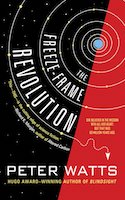
The Freeze-Frame Revolution (Tachyon), the shortest and latest novel from Canadian Peter Watts, is as brilliant and enticingly acute as any of his earlier and longer work. Running with the common SF trope of a ship traveling the galaxy at sub-light speeds to set up gates enabling instantaneous transport, Watts bursts through accepted story outlines to tell us what life is like for those aboard. Cryogenic sleep shifts last hundreds of centuries. The mission, after millions and millions and millions of years, goes on under the implacable and inescapable eye of an artificial intelligence tasked with keeping the crew’s nose to an eternal grindstone. How can its favorite human Sunday Ahzmundin and a few thousand others possibly manage to rebel against their superhuman supervisor? With skin-creeping tension, sharply realistic detail, and action moving fast as thought, Watts shows us.

Armistice (Tor) is Lara Elena Donnelly’s second novel, the sequel to her award-nominated debut Amberlough. Though it’s evident there will be at least a third book in this series set in a 1930s-ish, Cabaret-like fantasy milieu, Armistice suffers none of the weaknesses usually inherent in literature’s middle kids. Instead of a conglomeration of thin, unsatisfying scenes meant to serve as a bridge between the overarching tale’s explosive beginning and its no doubt spectacular end, Donnelly gives us a gorgeous book about bridges — metaphorical ones: distasteful but pragmatic political alliances, undying loves, all the connections humans make as we find our way through the world. A few favorite characters from Amberlough reappear, such as Aristide, the flamboyant nightclub emcee and drug-runner now unwillingly enmeshed in illicit gun dealing; and Cordelia, guttersnipe stripper-turned-terrorist. Conspicuous by his absence is Cyril, a sometime spy for the Nazi-esque Ospies and Aristide’s presumed-dead darling, but Cyril’s sister Lillian ably steps up to fill his role. Her close physical resemblance to her brother shocks and disturbs Aristide; her similarly double-dealing relationship with her Ospie employers hinges on the son they hold hostage. Various rumors, rescues, and releases coincide toward the book’s end — always believably, always unpredictably, and always in a superbly written, Art Deco-inspired atmosphere of louche extravagance.

What if a proponent of mainstream literature decided to write a horror novel? Julia Fine’s What Should Be Wild (Harper) seems to approach that genre in the same spirit in which Margaret Atwood took on dystopian science fiction when she wrote The Handmaid’s Tale: rigorously conscious analysis of its underlying psychology combined with willful ignorance of her story’s literary forebears and the efforts of contemporaries along identical lines. Linking female sexuality to the concept of untamed woods and tracing its unfair hampering back to a 6th century patriarchalist invasion of Britain, Fine switches between the narrative of a “good girl” struggling not to abuse her literal power of bestowing life and death, and vignettes focusing on her ancestresses the woods has claimed as its own. The novel’s imagery is visceral, but the feckless protagonist’s passivity leeches it of strength.
Couple of upcoming cons
For years, con going cognoscenti have been informing me I really ought to head to Boston to attend Readercon. Welp, this year I’ll be there for sure, because I’m one of two living Guests of Honor. The other is the redoubtable Ken Liu, and the dead (or more politely, memorial) GOH is my idol E. Nesbit. Besides us official big deals, unofficial ones such as Samuel R. Delany and Ellen Datlow will be on hand to celebrate the genre’s literary aspects. Which is what Readercon is about, in case the name didn’t clue you in: books, magazines, and texts of all sorts — the power of narrativity.
Closer to home, Portland’s steampunky GEAR Con also has a specialized focus — but based on content rather than format. 2018’s theme is “the Great War.” World War I took place in the interstices between the Victorian era commonly associated with the steampunk subgenre and the later, Art Deco-influenced period referenced by Amberlough, Armistice, and that whole dieselpunk movement. SoGEAR Con’s usual “adorable chaos” (as one frequent attendee describes the Tesla-coil demos, mad tea parties, and other activities) may have a more militaristic bent this year. Streamlined bumptiousness, anyone?
Future Alternative Past: The word we want is "inclusive"
Every month, Nisi Shawl presents us with news and updates from her perch overlooking the world of science-fiction, fantasy, and horror. You can also look through the archives of the column.
One of us
I hate “diversity.” Diversity is a white person word. A male, cis, het, able-bodied word. A word that presumes its own characteristics are the world’s default settings even as it seeks to leaven them with “otherness.” That arrogant lack of awareness is why I prefer to talk about inclusiveness in SFFH. Inclusiveness means including in what you’re doing those whose traits differ from the dominant paradigm, not just sprinkling them on top. Inclusiveness allows for the possibility that those included have some say in the matter of where and when they’re included, and how, and whether they’ll want to reciprocate. It de-centers and de-privileges the unmarked state.
Thank you. I’ll be here all week.
Climbing down off my hobbyhorse, now, and removing the rhetorical gear that helps me ride it, I’ll mention a couple of surveys showing how inclusive SFFH publishing isn’t. In 2016, Fireside Fiction published a special issue on the presence of black writers in the field. Strange Horizons conducted its own annual investigations of the numbers of the genre’s women reviewers and reviewees from 2011 through 2015, modeled on those of non-genre magazine Vida.
What Fireside and Strange Horizon found was extraordinarily depressing: women and blacks were represented even more poorly in SFFH publications than in the sadly lacking mainstream venues Vida examined. And yet I have seen an improvement in that representation in my lifetime. And I hope to see more.
For many years I’d approach any visibly black person attending a convention where I found myself. “Hey, look!” I would say, rudely pointing. “Another one!” Then I’d introduce myself. Easy enough to be this forward when only a dozen of us attended any fannish gathering. But a few years back I went to a con with over a hundred People of Color present, among them a couple score of African descent. The face of fandom had quite literally changed.
The prime mover behind this change is Con or Bust, a nonprofit providing hassle-free grants to People of Color wishing to attend SFFH cons.
Originally Con or Bust operated under the umbrella of the Carl Brandon Society, a nonprofit I helped found in 1999. The CBS administers a scholarship fund in Octavia E. Butler’s name and also gives out $1000 literary awards. Another band of social justice warriors, the James Tiptree, Jr. Literary Council, presents awards to SFFH that “explores and expands our understanding of gender” and two annual fellowships supporting gender-exploration-focused projects-in-progress.
So CBS members and the Tiptree “motherboard” and similarly-minded groups have hunkered down to make inclusiveness on myriad axes of difference the done thing. And the results are evident. And also, as predicted by polymath Samuel R. Delany in his groundbreaking essay “Racism and Science Fiction,” with growing influence and increased economic rewards for the formerly marginalized have come savage attacks by those to whom the loss of unearned privilege equals oppression.
Lately, though, there’s been an upwelling of still more inclusive-mindedness among SFFH’s gatekeepers: publishers, editors, award juries, agents, critics, and so on. Because the box office success of Black Panther proves, stunningly and conclusively, that there is an audience for stories of the vast majority of us, those who don’t fit the dominant paradigm. A paying audience. A big one.
Usually I link to relevant titles when I write these Futuristic Alternate Past raves. Not this time. There’s enough material out there that I’m going to encourage you to refer instead to others’ lists: winners and honorees of the Tiptree; nominees for and recipients of the CBS Parallax and Kindred Awards; entries at SF Mistressworks; my own Crash Course in the History of Black SF. I know there are others. I know you’ll find them.
Recent books recently read
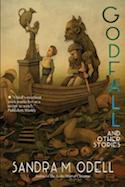
Godfall and Other Stories (Hydra House) collects most of the often-online work of prolific new author Sandra Odell into one print volume. Odell is a flash fiction adept, and Godfall’s shortest stories glitter with the brightness of well-polished lenses, offering sharply focused glimpses of her imagined worlds’ scary beauties. Longer pieces, like the title novella, carry their heftier weight with seeming effortlessness: butchering divine carcasses, rescuing kids from nuke-rigged chains, sipping immortality from their family’s empty wineskins, these characters lift Odell’s improbable situations from the page, from mere words to life. Along with the stories she shares notes on their genesis. Both Odell and editor Cat Rambo mention the author’s clueless use of a racial slur in an earlier draft of “Black Widow,” for which she was ostracized by appalled critique-mates. She’s learned an immense amount about representation from that experience, as these meticulously aware stories show.

Second of The Murderbot Diaries, Martha Wells’s Artificial Condition (Tor) does a bang-up job of filling in newcomers to the series. The books are a happy blend of crime procedural and far-future hard science fiction. Murderbot, a self-aware security robot investigating its own apparent massacre of innocent civilians, narrates its adventures in an easygoing, casual tone that’s also logically rigorous. Aided by a bored sentient research ship, it infiltrates the onsite records of the mothballed mining operation where it supposedly went berserk. Further explorations are scheduled for the Diaries' last two books, to be released later this year to clamoring fans — among them Kate Elliott, Ann Leckie, and me.
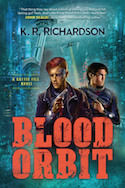
K.R. Richardson is actually local fantasy author Kat Richardson. The new byline appears on the cover of Blood Orbit (Pyr), her vision of the intersection between noir and the black depths of space. On a corporate-owned planet, a rookie cop and a world-weary detective with experimental cybernetic implants team up to solve the mystery behind an apparently pointless mass homicide. There are racial clashes and routine shows of class hostility, but what really got under my skin was the practical nastinesses of Inspector Dillal’s machine grafts. No Neuromancer-esque ease, no automatic jacking-in for Dillal. Postsurgical pain clenches his jaw, the threat of infection pits him against a doctor more concerned with lost time and equipment than his health, and colleagues wince and retch at his disturbingly chimeric appearance. A truly tragic mulatto, and an appropriate hero for this affecting cross-genre tale.
Couple of upcoming cons
ConCarolina came that close to highlighting an unrepentant sexist and homophobe as their Guest of Honor. Wisely, they’ve replaced him with the redoubtable Seanan McGuire, representative of a few non-dominant paradigm traits her own self, and also the author of a zombie novel that made me cry. Go bask in her wit, talent, beauty, and graciousness, forgetting the mistake that was not made.
The Locus Awards Weekend takes place again in Seattle this year. As I wrote in my May 2017 column, a light program of readings and panels supplements Saturday’s big deal awards banquet. New for 2018: three free memberships to People of Color! Do you qualify? Apply via the link at the top of this paragraph and you may witness firsthand that magical moment when emcee Connie Willis bestows a plastic banana upon the wearer of the ugliest and least authentic Hawaiian shirt.
Future Alternative Past: drugs
Every month, Nisi Shawl presents us with news and updates from her perch overlooking the world of science-fiction, fantasy, and horror. You can also look through the archives of the column.
Purple Haze
Drugs are good. Well, maybe not all drugs. But as a whole, as a group, they’re meant to help. And usually they do.
In SFFH, better living through chemistry is brought about most famously by the “spice” melange, a drug absolutely essential to navigators steering around interstellar trading ships. Frank Herbert’s influential 1965 novel Dune focuses on the fortunes of those who own the planet Arrakis (melange’s sole source), but there are also memorable portrayals of the blue-eyed, spice-addicted members of the interstellar Pilots Guild and the secretive “Bene Gesserit” cult, and Arrakeen natives.
Of relevant recent science fiction titles the best is Autonomous by Annalee Newitz. Her heroine, Jack, fabricates bargain-priced pharmaceuticals that buyers around the world dose themselves with for effects ranging from hangover-less partying to long, productive workdays.
Perhaps it’s authors’ need for conflict that causes us to concentrate on drugs’ negative effects. Even melange, in its creator’s mind so beneficial, so widely accepted, is also imagined as addictive. The “herbal” preparations imbibed by sword-and-sorcery’s favorite freak, Michael Moorcock’s cursed hero Elric of Melnibone, are also de facto addictive: without them he would die.
From good drugs that do bad things it’s a short step to plain old pure evil. The soma of Aldous Huxley’s Brave New World is the archetypal chemical oppression-enabler. Rendering the masses calm and mildly euphoric, self-administered soma greatly aids the maintenance of the novel’s global dystopia. There are scores of compounds with similar functions in later SFFH, such as the protein shakes consumed by slaughterhouse workers in Vandana Singh’s “Are You Sannata 3159?” (appearing in a collection reviewed below).
Often SFFH merely slaps a weird new name on an already existing drug. This is known in the trade as "calling a rabbit a smeerp,” and it’s annoying as fuck. Cute substitutes for the word coffee such as “klah,” “gvi,” or “caf,” don’t prove that readers have been transported to another realm. They prove that they’re in thrall to a short-cutting writer. Far more interesting are the stories casting aside well-worn tropes, as John Crowley does in Engine Summer, when his protagonist tokes up daily on pipes full of St. Bea’s Bread which is...not a drug.
Sometimes fantastical pharmaceuticals advance the plot, but don’t diverge much from the drugs we know; in her near-future novel Slow River, for example, Nicola Griffith’s heroine Lore may as well be ingesting heroine or meth or cocaine as the nameless drug that gets her through weeks of sex work. Sometimes they’re a collage of the traits of more familiar substances, like athelas or kingsfoil, the healing herb Aragorn uses in J.R.R. Tolkien’s The Fellowship of the Ring (partaking of several characteristics of mints and basil). Sometimes, in some skiffy stories, future drugs are identical with currently available ones, but they’re produced differently — manufactured in a vacuum or a zero-g environment, or grown in moss or duckweed, or in genetically-engineered milk animals. Which is where SFFH leaves off and reality takes over. Because these methods are being used right now.
Recent books recently read
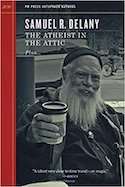
Samuel R. Delany is one of the baddest of literary badasses. In 1962, at the ripe age of 20, he published his first novel, The Jewels of Aptor, and went on to win a slew of Hugos, Nebulas, and other major awards. Now he’s 76, and the latest entry in his decades-long career is The Atheist in the Attic, a collection from PM Press’s “Outspoken Authors” series. The title story posits secret encounters between Leibniz and Spinoza in historical Amsterdam — nothing sfnal here, but the novella’s Delanyesque explorations of meaning, mood, intention, and imagination are as delectable as any in his genre fiction, and as rich in the cognitive estrangement SFFH readers prize. It’s followed by “Racism and Science Fiction,” the influential 1998 essay which led to the founding of the Carl Brandon Society and which, sadly, proved all too accurate in its prediction of racist reactions to a growing nonwhite presence in the field. A brief interview conducted by Terry Bisson concludes this slim but essential book.
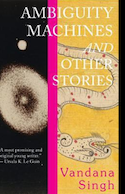
Another collection, Vandana Singh’s Ambiguity Machines and Other Stories (Small Beer) showcases a bit of what we’re fighting for. It’s a xenophile’s treasury of nonstandard plots, unfamiliar and finely crafted characters, and new ways to embrace the wonders of the universe, with particular attention paid to their scientific bases (Singh is a physics professor). My personal favorites are “Cry of the Kharchal,” a short story about birdwatching, time-traveling ghosts, and blocked poets; and a novella original to this publication, “Requiem.” Though the latter’s premise — a young woman seeks answers in the mysterious death of her aunt — provokes boredom by its mere mention, the actual story falls into none of the time-worn trope-traps you’d expect and delivered me, by its end, into a harsh but hopeful landscape.
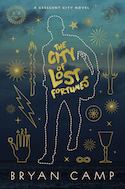
Bryan Camp’s debut, The City of Lost Fortunes, (Houghton Mifflin Harcourt) was written in the back of a car escaping the ravages of Hurricane Katrina. It’s a novel haunted by New Orleans’ near-death experience. Filled with supernatural extensions of the cultural diversity the city’s famed for, Lost Fortunes introduces readers to Jude Dubuisson, a racially ambiguous demigod who’s tired of his divine powers. Dubuisson gets drawn into a rigged card game everyone tells him he can’t win, but since they expect him to play fair they’re in for a surprise. Camp clearly cares for the Crescent City’s soul, and he brings its scenes to sweltering life: the cafés, cemeteries, flood-damaged ruins, low-life bars, botanicas, pelican-skimmed causeways, diners, guard dogs, festivals — a phantasmagoric panorama of a true urban fantasy.
Couple of upcoming cons
Once again I recommend attending WisCon. It’s a favorite both of mine and my mom’s: chock full of decadence, wit, and glitter-laden feminazgûls. There’s a transgressive rave, childcare, a quiet room for sufferers of sensory overload, and a bake sale. This year’s Guests of Honor, the indomitable Tananarive Due and the intrepid Saladin Ahmed, will give their rousing keynote speeches over a feast of meringues, brownies, mousses, and other sweets. Come. Partake. If you can’t save the world with chocolate chip cookies, it’s not worth saving.
Or perhaps you’d rather not make a trek to the Midwest during the humid warmth of May (WisCon’s held in Madison, Wisconsin). If so, try BayCon, just down the coast, ten minutes from Frisco. This year the theme is Patchwork Fandom: Stitching the Generations Together (appropriate, given recent kerfuffles over congoing fandom’s alleged ageism). Guests of Honor include our local Girl Genius, Margaret Organ-Kean, artist and Magic the Gathering card illustrator extraordinaire.
The Future Alternative Past: now with animal pictures
Every month, Nisi Shawl presents us with news and updates from her perch overlooking the world of science-fiction, fantasy, and horror. You can also look through the archives of the column.
Dog stars

Like so many writers, I have a cat. Minnie’s her name, and she’s pretty punk. But it’s the dog I didn’t get instead of Minnie I’ve written stories about, and it’s dogs in stories I’m writing about here.
First title in the Table of Contents for my imaginary SFFH reprints anthology About a Dog is Bradley Denton’s fabulous “Sergeant Chip,” winner of the 2005 Theodore Sturgeon Memorial Award. Chip, the technologically-enhanced K9 (canine) soldier, narrates a war-time encounter that calls into heart-twisting question his doggish loyalties.
Next would come Kelly Link’s “The Hortlak.” Which maybe isn’t about a dog at all. Dogs are in it. But so are zombies and pajamas. A protagonist working in a convenience store near the “Ausible Chasm” (a zombie point source), yearns after an animal shelter worker who treats the dogs she euthanizes to pre-injection car rides. Just your typical Kelly Link story, and more an exploration of doggishness than of dogs. I still want it.
Connie Willis’s Hugo and Nebula award-winning “The Last of the Winnebagos” would be in there, too. It is clearly and certifiably about dogs — though more specifically it’s about their absence in the wake of a devastating plague, and the lengths people go to so they can hold onto the special relationship we’ve formed with dogs over the last few thousand years.
I’d also need to include some version of Harlan Ellison’s brutal, elegant, and arguably misogynistic “A Boy and His Dog.” That’s the story of 15-year-old Vic and his telepathic canine partner Blood, scavenging their way across a post-nuclear holocaust wasteland. Then, as a restorative, I’d add one of Michael Swanwick’s tales of professional ne’er-do-wells Darger and Surplus. Though Swanwick describes Surplus (full name Sir Blackthorpe Ravenscairn de Plus Precieux) as a bipedal talking dog dressed like a refugee from Mother Goose, he originates in the far-future demesne of Western Vermont, a product of “the gene-mills of Winooski.” For actual fantasy I’d turn to J.K. Rowling’s Harry Potter series and excerpt a Hagrid/Fluffy scene or two. You remember Fluffy, the three-headed Cerberusesque guardian of the Philosopher’s Stone, right?
Should I likewise excerpt a dramatic passage from Stephen King’s Cujo? I’ll have to read it to find out.

Could be reprinting my own canine horror story would be easier to arrange. “The Tawny Bitch” combines a spectral dog with references to Charlotte Perkins Gilman’s feminist classic “The Yellow Wallpaper” and the recently discovered luridly sensationalist fiction of Louisa May Alcott (kidnapped heiresses! murder! opium!). On the other hand, maybe I’d want to reserve myself a spot instead for “Black Betty,” my talking dog story and homage to one of the smartest, bravest, sweetest Beagle mixes I’ve ever known.
The funnest part of compiling this imaginary anthology would be tying together these very disparate stories — stories differing in subgenre and style and the extent of their engagement with dogs and dogness — with an introduction. Or an afterword. Or both. I’d write about our longest running attempt at interspecies communication, and about the experiments in which we killed Laika and countless, nameless others of our so-called best friends. About the knowledge we’ve won and shared together, and the wisdom yet to come.
Recent books recently read
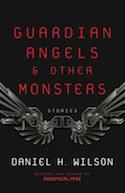
No one better conveys the thrill of technology’s advance than Daniel H. Wilson, author of the NYT bestseller Robopocalypse and the nonfiction guidebook to an imagined future Where’s My Jetpack? Guardian Angels and Other Monsters (Vintage), a new collection of Wilson’s short stories, showcases his loving ambivalence toward Artificial Intelligence’s potential in particular. Which will we encounter in years to come: the indomitably loyal AI nanny foiling its charge’s kidnapper in “Miss Gloria?” The wide-eyed, impressionable student of “Jack, the Determined?” Or the pitiless soldier-highjackers of “Parasite?” Fast-paced and vivid,Wilson’s takes on these possible scenarios seem simultaneously surprising and inevitable, even as they contradict one another. There’s a depth of feeling arising from the different perspectives he provides: peeking through them, poking around behind, we get a good sense of the endless layers awaiting us in all his work.
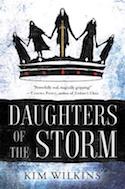
Daughters of the Storm (Del Rey) by veteran Australian author Kim Wilkins begins a saga-like series about a royal dynasty ruling a realm reminiscent of the setting for Beowulf. Magic is real, and cares very little whether it’s also clean, convenient, or fair. Five sister princesses struggle for power when a mysterious spell strikes down their father: Bluebell, a born warrior, battles those she suspects of foul play with sword and armor, while Ash apprentices herself to a murderous shapeshifter to learn enchantment’s ways, and Rose weds and then betrays the monarch of a patriarchal neighboring land. The two youngest girls, Ivy and Willow, are the least family-minded and also (not coincidentally) least likeable of this bunch, but even they come across as totally fascinating and believable, thanks to Wilkins’s talented tale-spinning — though I must admit it’s Bluebell who truly won my heart.
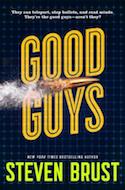
Steven Brust’s Good Guys (Tor) leaves behind the vaguely 16th century milieu of his bestselling Vlad Taltos books for modern times. The novel moves from plot point to plot point in the comforting rhythms of a classic thriller, as super spies investigate their organization’s infiltration by baddies. But these super spies only earn minimum wage and supplement their espionage with data entry work. The fact that they’re also trained as magicians does nothing to undermine the necessity for that, and nothing to ensure they’ll win. After all, the bad guys use the same magic. Combining the suspense resulting from this situation and the characters’ ironic commentary, the prolific Brust has written yet another highly enjoyable read.
Couple of upcoming cons
Originally located in Edgar Allen Poe’s hometown of Richmond, Virginia, Ravencon now offers attendees its panels, tournaments, workshops, readings, concerts, movies, and charity auction in Williamsburg, 50+ miles east. With four Guests of Honor — Gaming, Music, Art, and Author — Ravencon emphasizes multiple SFFH modalities while staying true to that ancient con philosophy: the community that geeks together fleeks together. Or words to that effect.
Not far off, in Washington, D.C., the USA Science and Engineering Festival will provide a free weekend’s access to nerd heaven. Pavilions focused on space flight, robots, secret codes, and a wealth of other mind-melting fields of knowledge will entertain participants between stage shows put on by an “explosive chemist,” a “stunt scientist,” and a gentleman respectfully referred to as “Mr. Freeze.” If all this sounds a bit PG-13, that’s deliberate: kids are the Festival’s target audience, though we curious adults are not excluded.
Future Alternative Past: in need of schooling
Every month, Nisi Shawl presents us with news and updates from her perch overlooking the world of science-fiction, fantasy, and horror. You can also look through the archives of the column.
The best way to learn something
My friend Kristin King asked a while back for book recommendations on Facebook, as you do. But she was looking for something very specific: science fiction dealing with schools. I only came up with two titles for her. First, John Varley’s lovely, haunting, and somewhat contrarian Beatnik Bayou, then my own rather hard-to-locate "Walk Like a Man".
Originally published in George R.R. Martin’s New Voices III anthology, and now available in the 2004 collection The John Varley Reader, Beatnik Bayou tells how a far-future child learns from and eventually outgrows her teacher. The teacher’s development has been artificially arrested at a point beneficial to the student. That part of the job description carries with it a whiff of tragedy — especially as we realize as the story ends that the teacher actually likes the career’s built-in limitations.
“Walk Like a Man” appeared in 2015 in the first and only issue of the wondrous literary journal Bahamut. It takes place in a future school whose primary raison d’être is socialization rather than the imparting of knowledge. Which is why my AI protagonist attends.
With help you can find many more examples, even without expanding the search into other speculative fiction subgenres. Isaac Asimov’s “The Fun They Had,” set in 2157, similarly supposes that learning per se can be imparted without schools; children discover a book describing groups of students attending classes together and dream longingly of sharing the experience.
Lots of school-related SF tales use this Matrix-like template of downloadable knowledge (as when Keanu Reeves declares “I know kung fu!”). Not all of them, of course; Zenna Henderson’s Holding Wonder collection includes short stories based on different plots, such as “The Indelible Kind,” in which a teacher and a student rescue a Russian cosmonaut. The Binti novellas by Nnedi Okorafor take place at an exclusive off-planet university.
Horror typically replicates the awfulness of the compulsory school experience. Stephen King’s Carrie, for instance, details the vindictive bullying and ostracism that sends his telekinetic heroine into a killing frenzy. But The Girl with All the Gifts by M.R. Carey changes that up; it starts off in a school for zombies.
School-centered fantasies such as J.K. Rowling’s Harry Potter series or Okorafor’s Akata books postulate schools for teaching the practice of magic.
My favorite of this genus is A Wizard of Earthsea, by the late great Ursula K. Le Guin, in which fledgling magician Sparrowhawk matriculates to such a school on the Isle of Roke. I’m also partial to her short story “The Day Before the Revolution.” Though elderly protagonist Laia Odo doesn’t teach anarchist theory formally, classes of all ages take field trips to visit her. She enjoys the company but privately abhors her role as surrogate mother.
Of course “The Day Before the Revolution” would be classified more as SF than F, bringing us back to where we started.
If science can be defined as a way of knowing, then some of these sorts of school-related stories can be considered meta-science fiction. At the very least the overall category merits an additional “s”. A list of readings in SSFFH by Seanan McGuire, Greg Bear, Naomi Kritzer, Caroline Stervermer, and its other authors would make a lovely syllabus.
Recent books recently read
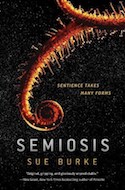
Is Sue Burke’s first novel, Semiosis (Tor) hard or soft SF? It takes place on an extra-solar planet, chronicling three pioneering generations of an Earth-based colonizing effort. But it’s by a woman, and it deals primarily in the “squishy” biological sciences. So, hmmmm.
Even before they land, the book’s colonists are in a jam: their 158-year voyage has brought them to the wrong sun! Failures in on-ship hibernation systems, and crashes destroying a third of their equipment further handicap the enterprise. They forge ahead — what else is there to do? As the colonists adapt to packs of predatory flightless birds and plant-based intelligences, Burke’s title (which my online dictionary defines as “the process of signification in language or literature”) gains meaning and resonance. The author’s clear, straightforward narrative style underscores the intrinsic ambiguity of interspecies communication, and the dangers and potentials of that ambiguity.
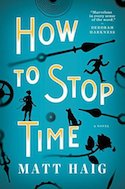
How to Stop Time (Viking) by Matt Haig reads like a paranormal romance — think a masculine version of the novels of Deborah Harkness or Diana Gabaldon. Yet it can easily be classified as science fiction. There’s nothing inherently impossible in a genetic mutation that allows its bearers to live 15 times longer than the rest of us. No supernatural abilities are necessary to ensure the successful machinations of Hendrich, who nicknames his fellows in longevity “albatrosses” and uses them to run his murderous errands. The love that binds protagonist Tom Hazard to his 17th century wife Rose, and then again to 21st century French teacher Camille, is completely understandable and human. I was sometimes impatient with Tom’s interiority and fecklessness, but quite pleased at the presence of disabled and nonwhite characters sans unnecessary (in my view) rationales for their existence. A fine and fascinatingly down-to-earth look at longevity.
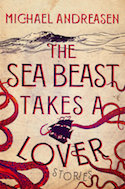
The Sea Beast Takes a Lover (Dutton) collects short stories by UC Irvine MFA graduate Michael Andreasen. His debut is marketed as both “contemporary fantasy” and “literary fiction.” It could be categorized as what my old writing instructor Howard Waldrop calls “a New Yorker-cup-of-coffee-style story” — if the coffee cup were being held out to you by a tentacle. Yes, you take about the same amount of time to read one of these stories as you would to drink a latte. And yes, per Howard’s annoyed assessment, there are times when protagonists’ situations seem static and their character arcs flat — or as he puts it, “The deer is dead at the beginning of the story and at the end of the story the deer is still dead.” But as you sip you’ll ruminate on greasy-skinned Rocketeers and bodhisattvan baby brothers, on Kerouac-reading mermaids and disappointed adulterers comparing their mistresses’ breasts to raw eggs. Which is not without its rewards.
Couple of upcoming cons
The organizers of the Association of Writers and Writing Programs Conference probably prefer for it not to get lumped in with genre conventions. Academia is the watchword, with works in fantasy, horror, and science fiction considered noteworthy simply because they’re outside the literary mainstream. Panel titles (and it’s pretty much all panels) include “The Mentor/Mentee Relationship for Creative Writers,” “From Thesis to Published Book,” and “Building a Social Justice Curriculum.” I’m there.
Meanwhile, the Outer Dark Symposium on the Greater Weird is also hovering at and around the traditional convention plateau without quite landing there, having approached it from a totally different direction. Abolishing economic boundaries between professional writers and fandom, the Outer Dark asks all attendees to pay their way. The focus on genre edginess and the presence of authors of color such as Craig Laurance Gidney and Silvia Moreno-Garcia are elements carried over from the compellingly intersectional podcast with which it originates.
Future Alternative Past: Sound it out
Every month, Nisi Shawl presents us with news and updates from her perch overlooking the world of science-fiction, fantasy, and horror. You can also look through the archives of the column.
Music of the spheres
Whenever I give an SFFH reading I also sing. And at their public readings, Pan Morigan and Andrea Hairston sing and play original songs inspired by Andrea’s novel Redwood and Wildfire.
No one knows how or why music so easily evokes emotions, but we three are certainly not above using it to do so. If I want people to long for an age yet to come I repurpose the lyrics of “Ode to Billy Joe” or rewrite a lullaby I learned off a Miriam Makeba record. Andrea, Pan, and I aim our skiffy at your earhole, and we’re not the only ones.
In fact, there’s a whole aesthetic movement, Afrofuturism, highlighting the connections between all Afrodiasporic art forms and speculative fiction. The musical groups Sun Ra Arkestra and Parliament-Funkadelic are foundational Afrofuturists: in the 1950s, Sun Ra traced his origins to Saturn; and Parliament-Funkadelic invoked a Mothership connection many a 1970s freakazoid knew in their alien(ated) heart to be true. Not just knee-deep, they were totally deep, and Jimi Hendrix’s homages to the genre range from the black magic fantasies of “Voodoo Child (Slight Return)” to his Philip José Farmer-inspired "Purple Haze." Michael Jackson’s songs provide a similarly wide spectrum: there’s the horror-evoking zombie menace in “Thriller” and the intergalactic love revolt of Captain Eo framing “Another Part of Me.” Prince not only read and sang speculative fiction, he embodied it. Present day Afrofuturists include Janelle Monae, who sings of androids, and Seattle DJ and author Gabriel Teodros, contributor to the anthology Octavia’s Brood and to CopperWire’s “hip-hop space opera” Earthbound.
And of course the intersection of SFFH and music extends beyond Afrofuturism. Certain of the lyrics to Steely Dan’s 1977 hit “Deacon Blues” derive from Alfred Bester’s classic SF novel The Demolished Man; the band’s name itself is taken from that of a dildo central to William S. Burroughs’s phantasmagoric Naked Lunch. David Bowie’s Ziggy Stardust metasaga explores the life of a glamrock star modeled on Bowie himself, and while it’s not strictly sfnal, it intimately concerns the ties between music and imaginative fiction. Which are everywhere, once you start looking: punk rocker Poly Styrene belting out “The Day the World Turned Dayglo,” Rocky Horror Picture Show’s Tim Curry exhorting us to do the Time Warp, Queen Bey calling for a ring to adorn her robot hand. Everywhere, musicians invoke SFFH.
And the reverse? Writers of SFFH inspired by music?
Early in my creative process I will often steal titles, settings, and incidents from songs — sometimes making off with entire plots, as when I lifted the storyline of a 16th century English ballad for “Cruel Sistah” (Later I wrote the lyrics to the blues my ghost sings at its climax).
A brief survey of my fellow social media addicts yielded dozens of similar anecdotes. Writers take inspiration where we can find it, from Television’s “Marquee Moon” (Stamping Butterflies by Jon Courtenay Grimwood) to Beethoven’s Ninth (“The Ninth Symphony of Ludwig Van Beethoven and Other Lost Songs” by Carter Scholz). Whole volumes are devoted to the concept, like Stars, a tribute anthology composed (hah!) of stories focused on specific Janis Ian songs.
SFFH authors put together playlists of music we listen to while writing particular stories; we write about instruments only nonhumans have the physical capability to play; we pen national anthems for imaginary countries and revolutionary hymns for nonexistent religions. We dance about extrasolar architecture.
Someone should probably write a book about it.
Recent books recently read

Marie Lu is best known for writing dystopian YA, but it’s not much of a leap from that subgenre to Batman: Nightwalker (Random House). Lu’s latest novel is full of urban grit and darkness, and at just-turning-18, Bruce Wayne’s appeal to Lu’s target audience couldn’t be more powerful. My high school sophomore niece said she hated me when I showed her my limited edition’s poster insert celebrating his hunkiness. At 62, I’m less vulnerable to those sorts of attractions, but the book’s first line hooked me: “The blood underneath her nails bothered her.” Ambiguously villainesque Madeleine Wallace is a perturbing and therefore appropriate opponent for a Bruce Wayne still battling the unacknowledged trauma of his parents’ recent death. Rich and isolated, gadget-loving and anti-authoritarian, Lu’s hero is a completely plausible adolescent version of comics’ favorite vigilante.
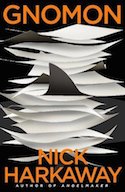
Nick Harkaway’s Gnomon (Knopf) combines, like Lu’s Batman, the self-sacrificing purity of an ethical investigator and a fascination with horizon-adjacent technology. And that’s about all the two books have in common. One is relatively straightforward, the equation to which a wave reduces; the other is as complex as the treasure-filled history of life beneath the sea. Broken-fingered Ethiopian artists; scheming, boastful, lovelorn math geniuses; and gigantic shark spirits roam the pages of Harkaway’s magnificent epic in hypnotically recursive patterns. Ostensibly it’s about the suspicious death of a dissident in a hyper-surveilled society, but there’s no way a mere synopsis or review can do Gnomon justice; the author himself admits that this book is too big to have ever fit in his all-too-human head. It must suffice simply to say that reading Gnomon will change you, and that afterwards you’ll be content with having changed.
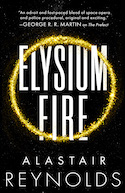
Elysium Fire (Orbit) by Alastair Reynolds also occupies that sweet spot found between police procedurals and science fiction. A sequel to The Prefect, it pits the Panoply, a sort of omnipresent, laissez-faire police force, against an epidemic of inexplicable, brain-frying murders. 25th century civilization comprises thousands of habitats orbiting the planet Yellowstone, and constant, electronically-aided polling makes for a true democracy. Dogged by the climbing death rate and a rabble-rousing secessionist, Prefect Tom Dreyfus and operatives Thalia Ng and Sparver (a genetically enhanced pig) struggle to preserve the integrity of their far-flung beat. Their struggles would be stranger and yet more enjoyable if Reynolds’ accounts of inevitable social change kept up with his depictions of the high tech ubiquitous in this shimmering bubble of an outer space utopia. I didn't quite finish the novel by deadline. I'm going on with it now; I expect cool action, but no major cultural novelties.
Couple of upcoming cons
Looks like I’ll be giving the keynote speech next month at Amsterdam’s Other Future’s Festival. I highly suggest you get on over there, too. Other guests will includeNnedi Okorafor, the great Grace Dillon, and Wanuri Kahiu, director of the Kenyan science fiction film Pumzi. There’ll be music to listen to and movies to watch as well as talks to attend. Plus, you know, it’s in Amsterdam.
Closer to home, check out Escapade in Los Angeles, “The Slash Slumber Party!” Slash, in case you didn’t know, is fan-generated erotica pairing nominally het characters of the same sex: think Spock and Kirk nuzzling each other’s throats. Escapade’s also big on shipping and vids; shipping’s like slash with less of a homosexual mandate and a longer dramatic arc; and vids are fan-produced, music-coordinated, trailer-length films repurposing scenes from (usually) sfnal shows. Escapade features hours and hours of vidding premieres, uncensored.
Future Alternative Past: where's the future wear?
Every month, Nisi Shawl presents us with news and updates from her perch overlooking the world of science-fiction, fantasy, and horror. You can also look through the archives of the column.
Fashion: Beep beep.
When I was little, my parents subscribed to Life magazine. It was our weekly dose of glossy photojournalism: enormous pages full of news and human interest stories. Though it’s been more than fifty years since I saw it, the Life article predicting 21st-century fashions still troubles my mind’s eye. I’ve lost the names of the designers consulted — famous ones, no doubt, given the publication’s prestige — and am left with a problematic whirl of brightly patterned muumuus, bald heads, and an inexplicable dearth of earbuds. Apparently Life was following a long tradition of magazines getting such predictions horribly wrong.
Has SFFH fared any better?
My favorite antidote to the unease Life stirred up in me is Samuel R. Delany’s brilliant, multiple award-winning novelette “Time Considered as a Helix of Semi-Precious Stones.” What works best for me is an early throwaway line about “a crowd of giggling, goo-chewing schoolgirls with flashing lights in their hair, all very embarrassed at wearing transparent plastic blouses which had just been made legal again” — that “again” signifying the undeniably cyclical nature of fashionableness.
And really, despite the sober idiocy of the formfitting unitard look promoted by matinee serial fodder like Buck Rogers, and the camp idiocy of the shoe phone used in the semi-futuristic TV series Get Smart, that’s what the genre has consistently gotten right: the inevitability of repetition and change. Another example: characters in Bruce Sterling’s 1998 novel Distraction wear hats as routinely as actors in a Frank Capra film. Headgear’s a given, barely remarkable — our current hatlessness is noted as a brief historical aberration. Actually, who’s to say it isn’t?
Speaking of shoe phones, while they were one of Get Smart creator Mel Brooks’ finest standing (ba-dum-BUM!) jokes, they do reflect an emerging reality: wearable communication and computation devices. Google Glasses have not taken the nerd community by expected storm, but their sfnal prototypes are popular, from William Gibson’s cyberpunk through Accelerando and related works by Charles Stross.
Another sartorial SFFH trope — disposable clothing — seems even further from realization. So far, 3D printers are no help. The kicky-mod-paper-dresses of the 1960s have given way to hazmat suits and adult diapers. And ubiquitous though recycling hoppers are on many fictional space stations and starships (I oughta know, having installed them in a few of my own stories), the process by which their contents get reconstituted into wearables is never explored. Therefore, we’ll score this concept as pre-execution.
A final kind of fashion in which SFFH takes the lead: body modification. Representations in imaginative literature range from integrated technology such as the “Zeiss-Ikon” eye-cameras in Gibson’s “Burning Chrome,” through the race-encompassing genetic modifications enabling my “Maggies” to work unprotected on an alien world, to the DIY anti-hallucinogen-manufacturing brain implants employed by the biohackers in Annalee Newitz’s novel Autonomous. Call me bereft of acumen, but I’m betting we’ll always want to improve ourselves, always be willing to revise our bodies and genomes. And that the sorts of revisions we make will vary with our abilities, but also, naturally, with what we perceive as new and cool.
Recent books recently read
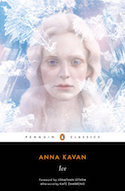
Anna Kavan’s Ice (Penguin), out now in a spiffy “50th Anniversary Edition,” is ultra-cool, and experimental enough that it will always in some way be new. This surreal proto-feminist account of a nameless male bureaucrat questing after a nameless female fugitive in the down-crashing shadow of a global eco-catastrophe is an astonishingly easy read, given its uncompromising weirdness. Lyric simplicity underlines the glacial starkness of the coming of a worldwide winter:
Banks of solid ice edged the narrow channel of blackish water, fringed with grinning icicle-teeth. I jumped ashore, snow blew out in great fans, the launch disappeared from sight. There were no goodbyes.
Conflating the crystalline fragility of the fleeing woman with the overwhelming power of the encroaching glaciers, opening up narrative discontinuities like bottomless rifts in a polar icepack, Kavan earns every iota of the respect paid her work by Anais Nin, Christopher Priest, Brian Aldiss, and Jonathan Lethem, author of this volume’s awestruck introduction.
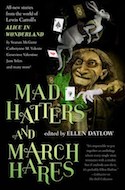
Renowned multiple award-winning anthologist Ellen Datlow has edited dozens of books stuffed full of good stories. Her specialties are dark fantasy and horror, and her latest, Mad Hatters and March Hares (Tor), provides a new way of combining these genres in her authors’ original tributes to Lewis Carroll’s Alice books. Unusually, Mad Hatters’ Table of Contents includes more females than males. Perhaps that’s due to the femaleness of the original series’ main character? If so, the point remains unbelabored. The spotty magic of Priya Sharma’s “Mercury” poignantly underlines capitalism’s careless reliance on toxins and its heartless expediency in the light of loss or damage to the lives of its creators. Catherynne M. Valente recounts a braided tale, “The Flame After the Candle,” in which an adventurous schoolgirl climbs through an old, neglected mirror to find relics left by a New York encounter between Alice Lidell — the real-life model of Carroll’s heroine — and Peter Llewelyn Davies, the boy on whom J.M. Barrie based Peter Pan. These and Andy Duncan’s brilliant “Worrity, Worrity,” which soaks the dry biographical material of Carroll’s illustrator, Sir John Tenniel, in an elixir of fabulous coincidence, are the strongest stories in an anthology featuring strength after strength.
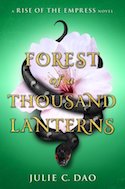
Two authorial decisions make newcomer Julie C. Dao’s Forest of a Thousand Lanterns (Philomel) a standout. First, no wypipo: in this fantastic China analogue, the closest readers come to a Caucasian viewpoint is the occasional mention of “barbarian” violins. Not that the realm of Feng Lu is suspiciously isolated; an ambassadorial entourage from the Nipponesque land of Kamatsu plays a major role in helping heroine Xifeng attract her emperor’s romantic regard. Second, said heroine is actually our villain — at least, I’m betting that’s how the rest of this series will shake out. Dao’s depiction of Xifeng’s struggle against the evil within is vivid and believable, her horror at her own burgeoning monstrosity always seems as if it might keep her from perpetrating her evermore dastardly deeds. Riveting inner turmoil sets the stage for an epic conflict to come.
Couple of upcoming cons
Seattle’s Rustycon has been happening for over 30 years. In addition to the usual writer and author Guests of Honor, they’ve invited a Gamer and a Furry as GOHs. Membership runs between 500 and 700 people, so this will be a small crowd of fandom's usual suspects. That’s January 12 through 14; mark your calendars.
On the following weekend, in fabled, far-off Detroit, I’ll be the Fan Guest of Honor at ConFusion Through the Looking Glass, latest iteration of the first con I ever attended. Back then, I dressed up as GOH C.J. Cherryh, my idol; now, I’m joined in playing myself in that role by several big names, including two who are also my friends: Annalee Newitz and Kate Elliott. Though I’m a little worried about the acclimatization of Kate, who currently paddles a blissful Hawai’ian kayak. At least she’ll have her fantasies to keep her warm. You too?
Future Alternative Past: impeccable taste
Every month, Nisi Shawl presents us with news and updates from her perch overlooking the world of science-fiction, fantasy, and horror. You can also look through the archives of the column.
Magellanic pseudopods and chipped funkleweed
Food in space! It isn’t always as vividly and goofily named as the cafeteria offerings listed above, lifted from the infamous Pel Torro’s godawful novel Galaxy 666. In fact their polar opposite, the tasteless and efficient food pills are fairly ubiquitous; they make an appearance as early as the Victorian SF story “The Senator’s Daughter” and are heavily featured in Twentieth Century media such as the cartoon series The Jetsons. The closest supermarket reality ever came to the dream of full nutrition in an easy-to-swallow pill was “Space Food Sticks,” a forerunner of modern protein bars which tasted like sweetened library paste mixed with chalk dust and rolled into brown cigar-shapes between dirty, sweaty palms.
Soylent Green, the mysteriously complete protein in wafer form whose ingredients are the icky crux of the 1970s movie of the same name, inspired Soylent brand “meal replacement” powders and drinks. Apparently the recipe for this version differs significantly from the cinematic one.
Vat-grown or printed meat such as Frederik Pohl’s immortal Chicken Little are often presented in SFFH as the food of the plebian masses: cheap and unappetizing, a sort of edible handjob. But they also stir up consideration of ethical questions around vegetarianism, the necessity for the suffering of living beings, and the negative environmental impact of traditional agriculture. The snobbishness evinced against faux foods is at times reversed, with one Jack Vance character, an advanced traveler to parallel dimensions, nauseated at the prospect of having to consume “the enlarged sexual organs of plants.”
But aesthetic issues aren’t always at the forefront of reasons given by SFFH characters for eating artificial meat. The closed ecology envisioned for most interstellar vessels necessitates it. And the low probability of finding nutritionally adequate foodstuffs off Earth necessitates it for longer than the duration of voyages already lasting years, decades, even generations. Working models based on truly rigorous planet-level biochemistry yield systems like that of Kim Stanley Robinson’s Aurora — unfamiliar forms of life inimical to our own. Various authors have dealt with this problem in various ways, including ignoring it, attributing its absence to a panspermian history of the universe, committing their fictional populaces to the eternal operation of huge hydroponics farms, and combinations of all three tactics.
The atevi homeworld described in C.J. Cherryh’s Foreigner series is a somewhat gentler version of the hostile planet-wide habitat; certain spices favored by the natives are pukingly poisonous to colonizing humans. Cherryh’s linguist hero Bren Cameron succumbs to near-fatal food pranking in one of the many nastily humorous cultural clashes she depicts.
A Jewish friend once remarked on the anthropology of keeping kosher, “The best way of maintaining a distinct tribal identity is to have strict rules about what you can and cannot eat, and how, and when, and where…If you can’t share a casual meal with your neighbors, you’re not going to share much else.” SFFH comestibles — including some arguably sentient beings — maintain the genre’s tribal identity by getting us to think about eating in familiarly estranged ways.
Recent books recently read
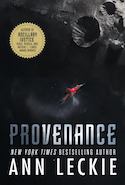
Take, for instance, Provenance (Orbit), Ann Leckie’s standalone follow-up to her multiple-award-winning Imperial Radch trilogy (Ancillary Justice, Ancillary Sword, and Ancillary Mercy). Both high and low class characters eat “nutrient blocks,” though only a former prisoner thinks to hoard them against possible hard times ahead. Provenance is the story of Ingray Aughskold, who stands to inherit her adoptive mother’s wealth, power, and eventually her identity. Between slurping down rehydrated noodles and munching nutrient blocks, Aughskold attempts to execute her daring plan to outshine her brother, the rival for their mother’s heirship. It’s an involved scheme centering on the theft and forgery of “vestiges,” super-sought-after memorabilia collected obsessively in Aughskold’s corner of the fictional Imperial Radch universe. But the plan has far too many moving parts, plus Leckie portrays her heroine as a bit of a klutz, always losing hairpins and accepting villains at face value. Her plan fails — entertainingly, of course. Add a Jack Vanceian flair for futuristic styles of dress and speech and Leckie’s trademark use of pronouns to matter-of-factly deconstruct the gender binary and you have a valiant successor to that rightfully much-vaunted debut trilogy.
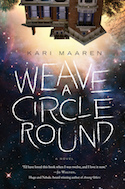
Critics and publicists compare newcomer Kari Maaren, author of Weave a Circle Round (Tor), to Madeleine L’Engle and E.L. Konigsburg. This debut novel certainly introduces readers to charmingly eccentric characters similar to those these vintage authors wrought. But it has its thoroughly modern elements as well: gaming is a legitimate creative venture; mixed race backgrounds are truly background; and blended families are equally unremarkable. The plot resonates nicely with typical youthful angsty outsiderness: 11-year-old protagonist Freddy Duchamp inadvertently goes time-traveling with one of her new nonhuman neighbors and discovers that her sad inability to conform may not be such a handicap as she thought it was…and that her pedantic baby sister and their barely tolerated stepbrother can help her outsmart archetypes-gone-wild who want to rule over her by virtue of the power of storytelling.
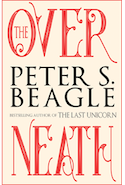
Peter S. Beagle, author of The Overneath (Tachyon) knows that power well, and wields it with the skill of a lifelong practitioner. Though the thirteen stories collected in this latest volume probably won’t change the lives of millions and provide a generation with its standard for what fantasy ought to accomplish — which his classic novel The Last Unicorn most assuredly did — they are lovely, strange, and an utter, heartwrenching joy. Two, “The Green-Eyed Boy” and “Schmendrick Alone,” are Last Unicorn prequels, telling how that book’s belovedly klutzy magician set off and limped along his career path. “Olfert Dapper’s Day” draws on material Beagle found when researching historic unicorn appearances. But my favorite story is the one featuring real-life author and shameless eccentric Avram Davidson, “The Way It Works Out and All.” Perhaps that’s because I so admire its subject, or perhaps it’s because Beagle’s clear-eyed-remembrance-cum-cautionary-tale perfectly sums up how reading this collection feels: like wandering through the Overneath that is its title, the reality between our many worlds.
Couple of upcoming cons
Don’t be fooled by the name: Anglicon is and always has been a decidedly local event. It will take place this coming December in SeaTac’s Doubletree hotel, the “Angli-” content provided, as is customary, by Guests of Honor and programming. Not one but two former Dr. Whos are coming — the fifth and seventh; Anglicon’s panels and masquerade will also reflect volunteers’ fascination with British TV-and-film-based SFFH. Proceeds benefit an area PBS station and British media purveyor.
Smofcon is a sort of meta-convention. In SFFH fanspeak, “smof” derives from the collapse of an ironic acronym standing for “Secret Master of Fandom.” Smofs run cons and other vital SFFH functions, and at Smofcon 35 in Boston this December, Massachusetts Convention Fandom, Inc. will present panels on the best ways to do that. Want to learn how to pick good Guests of Honor? How to run an inclusive event welcoming to all races, abilities, and genders? These folks can help.
Future Alternative Past: Let’s Talk About Fat Positivity in Sci-Fi
Every month, Nisi Shawl presents us with news and updates from her perch overlooking the world of science-fiction, fantasy, and horror. You can also look through the archives of the column.
Genre Heft: the real and the ideal
I’ve just returned from NINC — that’s Novelists, Inc. — a professional conference attended mainly by writers of romance and mysteries. Among the many differences between this crowd and my usual cohort was an absence of what is often referred to as "the fannish physique." In other, blunter words, obesity. At this event, weighing 280 pounds and straining the capacity of my O cups, I was a definite outlier.
Which goaded me into speculating about how the literary dimensions of SFFH reflects its physical oomph. The answer: That’s changing. For the better.
My first encounter with sfnal fatphobia came when I read Dune as a child: Baron Harkonnen, the book’s bad guy, is mountainously fat. Stereotypes of the obese depict us at one of two temperamental extremes: unrelentingly jolly or unrelievedly evil. Harkonnen’s the latter, but at the precocious age of thirteen what really struck me was how badass his anti-grav wheelchair must be in action. I wasn’t even a little "chunky" at that point, but wow was I jealous of him zooming around and zipping up over people's heads and popping in and out of palatial spaceships. Only later did I realize my hatred for him was actually supposed to be blended with disgust and pity. Not envy.
Pity is evoked much more successfully in James Tiptree Jr.’s “The Girl Who Was Plugged In,” which I previously discussed back in January. Perhaps because the author’s also going for empathy? Or perhaps because the heroine’s obesity is caused by a malfunctioning pituitary gland and thus in no possible way her fault.
Yet, with a wealth of futuristic medical technology at their disposal, why should anyone be overweight? The protagonist of Tanith Lee’s novel The Silver Metal Lover is tricked into fatness by her insecure mother, but loses her excess flesh with the support of an adoring robot. It’s all done with chemicals.
Horror novel Thinner’s body consciousness is of course horrific. Published as by Richard Bachman right before Stephen King admitted that this was a pseudonym of his, it’s deeply problematic in its depiction of curse-wielding so-called "gypsies." They cause the book's obese lawyer to shed pounds speedily, involuntarily, bringing him to death’s threshold.
The comic Bitch Planet’s Penny Rolle is probably the best example of fat-positivity in recent SFFH. It’s an ironic feminist take on exploitive "women behind bars" stories; the "Bitch Planet" of the series' title is the nickname of a dystopian dumping ground for "noncompliant" women. Rolle’s body is by definition noncompliant because it defies standard beauty standards. Which suits her, and me, just fine.
In another instance of a nicely-adjusted attitude toward body image, the narrator of "Venus Rising" by Carol Emshwiller (collected in Report to the Men’s Club speaks of young women maturing in terms of them “coming into” their fat.
In my own SFFH I do my best to represent non-stereotypical obese characters. The narrator of "Maggies," published in Sheree Renée Thomas’s second Dark Matter anthology, crushes out on a genetically engineered underwater terraformer whose extra-thick layer of fat insulates her from an alien planet’s cold seas. In "Otherwise," published in the YA anthology Brave New Love, 220-pound lesbian teenager Lo knows she’s lovable and loved. As are we all.
Couple of upcoming cons
Though Chessiecon resembles traditional SFFH conventions, it has only existed three years. It’s put on by the Thanksgiving Science Fiction Society as a sort of living memorial to a deceased local fan hight Jaelle of Armida. TSFS’s primary goal is promoting women writers; eleven of their twelve Guests of Honor have been women, so they’re backing that idea up with action. Chessiecon’s Turkey Award is given in recognition of awesomely bad writing á la Bulwer-Lytton; the implied irreverence colors the rest of the con’s programming as well.
This November’s World Fantasy Convention emerges from a pair of controversies: one focused on its HP Lovecraft-shaped World Fantasy award busts, the other on racist panel proposals of the past. Also it has survived the death of its founder, David Hartwell. Smaller than the similarly named Worldcon with which it’s sometimes confused, World Fantasy’s attendance tops out around 1000 smart, funny, incredibly interesting people — but there’s still time to sign up to be one.
Recent books recently read

An Excess Male (Harper Collins) is Taiwanese-born author Maggie Shen King’s debut novel. Expanding an idea originally published as a short story in Asimov’s SF Magazine, King fast forwards us to the lopsided genderscape of a future China shaped by the government’s infamous “one-child” policy. Her clearsighted, even-toned writing acquaints us pleasurably with plausible, engagingly flawed characters: Wei-guo, a 40+ bachelor finally in possession of the dowry necessary to purchase the position of third husband in an established marriage; that marriage’s wife, May-ling, hopelessly infatuated with her gay first husband Hann; Hann himself, balancing love for his child with desire for members of his discreetly naughty badminton team; and Hann’s brother and May-ling’s second husband Xiong-xin, whose autism is even more illicit than Hann’s homosexuality. Fearlessly piercing stereotypes in her assessment of what truly makes a family, King also seems to hew effortlessly close to cultural values, making the stresses and rhythms of her characters’ interactions feel authentically unfamiliar to this US-raised reader.

Not so with Elizabeth Bear’s latest novel in her entrancing Eternal Sky series, The Stone in the Skull (Tor). Though set in Asianesque fantasy lands, plot arc and scene beat and sentence all connect easily with a Westerner’s literary expectations. Those aren’t necessarily dependent on having read the three earlier Eternal Sky books, either. I found very little overlap between the old series and the one this new book begins in terms of characters: a slave-poetess here, an immortal automaton there, an aging veiled assassin everywhere. And the Lotus Kingdoms whereThe Stone in the Skull’s dynastic disputes occur lies at the edge of the previous trilogy’s map. There’s a secret message sent to one ruler, a disaster engulfing another…but summarizing its action conveys very little of this book’s undeniable attraction. That attraction is much plainer in Bear’s starkly vivid descriptions; her spare yet luscious language; and the stubbornly endearing people inhabiting her enthralling imaginary world.

A veteran SF author who’s also an engineer working in U.S. intelligence, Philip K. Dick Award-winner David Walton draws on his dayjob expertise in The Genius Plague (Pyr). Fungal sentience originating in the Amazon threatens the integrity of the intelligence community by influencing its members’ thoughts and desires. It cures the Alzheimer’s afflicting the protagonist’s father and rouses support for ecologically sound candidates and practices. But it’s also behind some rather nasty massacres and assassinations. Codebreaking and computer servers stand between the National Security Agency and this sporulating mind’s crop dusters and smoothie stands. It’s unclear by the novel’s end if humanity’s defenses will prevail. Or even whether they should. Perhaps we’ll know that after reading a sequel or two.
Future Alternative Past: covering it
Every month, Nisi Shawl presents us with news and updates from her perch overlooking the world of science-fiction, fantasy, and horror. You can also look through the archives of the column.
Judging a book
A cover’s the first thing you see when you look at a book. Maybe the spine alone — a wash of color, font(s) spelling out its title and the name of its author (with any luck, legibly). You see more if the book is “faced out,” that is, displayed so the front cover’s facing you, and you’re getting the full force of the artist’s and designer’s skill. What can you tell at first glance?
For starters, expensive treatments such as embossing, cut-outs, and foil or metallic inks mean the publisher thinks they’ll be selling lots of copies. Traditionally, the publisher’s got an in-house team taking care of the cover business; traditionally, authors have little to say about how their books are packaged beyond, if the publisher’s feeling extremely gracious, a chance to nix the chosen art. Which Tor gave me with Everfair; editor Liz Gorinsky showed me a preliminary sketch done by the brilliant Victo Ngai and I pointed out that the human hand in it should be black. And she made it so.
But protagonists’ races aren’t always something you can tell from a cover, alas. “Whitewashing” is the term we use for this problem. For every piece of representative and lushly dark Kai Ashante Wilson or Nnedi Okorafor cover art, there’s a counterexample, such as the weirdly pale version of Lilith Iyapo shown on the original edition of Octavia E Butler’s Dawn. Of course that last book was published thirty years ago; nowadays, a mostly abstract or alphabetic cover like the one on Zen Cho’s wonderful Sorcerer to the Crown is the compromise.
Not that there’s anything intrinsically wrong with alphabetic cover designs — one of my favorites is the cover for Kurt Vonnegut’s Slaughterhouse-Five, reproduced here on a t-shirt. But I contend it’s shabby of publishers to routinely use graphics to conceal information they think you shouldn’t have.
Because there are times they do exactly the opposite for the information they think you should. Goggles, top hats, and dirigibles on a cover signify steampunk; spacesuits and cratered, airless planetscapes signify “hard” science fiction; busty contortionists in jeans or leather catsuits signify “urban fantasies” about werewolves and private eyes. Delving deeper into this code, specific artists are identified with specific subgenres and even with particular authors: Thomas Canty with high fantasy, Kinuko Y. Craft with Patricia McKillip (I review a classic McKillip re-issue later in this column).
Publishers speak cover art fluently. If they want to.
Another thing you can usually tell from a book’s cover: who else thinks it’s cool. Traditionally, publishers are also in charge of soliciting “blurbs,” as the two-or-three sentences of praise bestowed by big names are called. The results can be edifying. If the book jacket prints a statement from Samuel R. Delany or Junot Diaz saying a debut novel is brilliant, I pay attention; if it’s lauded as amazing by someone who…isn’t…I pass it by.
So yes, often you can judge a book by its cover. But then there are those times when things go horribly wrong. The cover art for the first printing of Ted Chiang’s Stories of Your Life and Others has a clumsy Ayn Rand-paperback feel entirely at odds with the collection’s ambiguity and subtlety. “There’s a Bimbo on the Cover of My Book” laments a familiar filk song (folk songs for members of the SFFH community). “All too accurate,” one commenter proclaims of the song’s full lyrics.
One way around these messes is to self publish. Another is to publish with a small press such as Tachyon, Aqueduct, or Small Beer. In both cases authors are better able to plead their book’s cases to the judge and jury of the reading audience.
Couple of upcoming cons
There’s a first time for everything, including AfroComicCon, a Bay Area “comic book, art, media, science fiction, technology awareness, web TV, film, and writing convention.” You get all that for a ticket costing $7 to $30 — depending on which events you opt for. A free-of-charge Youth Community Day is promised also, though no details are available yet. Jaymee Goh and Zahrah Farmer Castillo are two of this fledgling con’s fourteen featured speakers.
VCON, on the other hand, has existed since 1971. This year’s VCON 41.5 is billed as a “relaxacon”: light on programming, heavy on socializing. It’s a format that will likely work both for longtime attendees who just want to hang out with old friends and newcomers who’d like to get a feeling for the con community. Structured only around the length of a movie or the rules of a game, VCON 41.5 could be a revealacon as well.
Recent books recently read
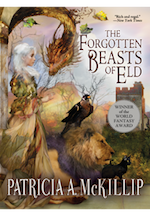
As noted above, recent covers for Patricia McKillip’s fantasies are almost always painted by Kinuko Y Craft. Except when they’re not; a new reprint of her groundbreaking World Fantasy Award-winner The Forgotten Beasts of Eld (Tachyon) is graced instead by Thomas Canty’s art. And why not? McKillip’s soaring prose, lyrics to songs our hearts have forgotten they knew how to sing, deserves Canty’s accompaniment. The feminist underpinnings of the book’s plot — a self-sufficient woman who refuses to be stripped of her autonomy starts a war she swore never to fight — deserve our attention now as much as they did in 1974, when Beasts was first published. If you’ve never read it, you deserve to. Or if, like me, you read it long ago and have made do since with a tiny but affordable mass market paperback, you deserve Tachyon’s elegant trade paperback edition, at least half as beautiful as McKillip’s story. Which sounds stingy as compliments go, but is actually extremely high praise.

Frankenstein Dreams (Bloomsbury USA), a retrospective edited by Michael Sims, is fourth in his series of Victorian SFFH anthologies. The book begins with a detailed introduction, then proceeds to work by Mary Shelley, author of what’s arguably the first modern science fiction novel, and ends with Arthur Conan Doyle, whose iconic sleuth Holmes epitomized the scientific approach to mystery. In between these two Sims manages to introduce several authors less familiar to modern SFFH readers, or probably to modern readers of any genre. He also takes the somewhat regrettable liberty of excerpting a minor and wholly non-sfnal Thomas Hardy novel, justifying it as an illustration of the anxiety the time’s scientific discoveries provoked. Other excerpts — of Verne’s Twenty Thousand Leagues under the Seas, of Shelley’s superb Frankenstein, of Wells’ The Island of Doctor Moreau, and of Stevenson’s Strange Case of Doctor Jekyll and Mister Hyde — may tempt the antho’s audience to read the complete novels they’re taken from. They stand up poorly to the real short stories appearing here, though, such as Poe’s “The Facts in the Case of M Valdemar” or my favorite, Mary E. Wilkins Freeman’s “The Hall Bedroom.” Gender issues are addressed in “A Wife Manufactured to Order” by Alice W. Fuller, and racial prejudice in Edward Page Mitchell’s “The Senator’s Daughter,” but for the most part Frankenstein’s Dreams seem to center on explicit monsters and the implicit estrangement of members of the era’s dominant paradigm.
Future Alternative Past: Present tense
Every month, Nisi Shawl presents us with news and updates from her perch overlooking the world of science-fiction, fantasy, and horror. You can also look through the archives of the column.
Conflict vs. tension
Something's got to happen. Who wants to read about happy characters dwelling contentedly in the land of status quo with no worries, no desires, no agendas? Paying customers prefer action. We authors love our characters (who are often facets of our own selves), but in pursuit of stories others will read we torture and provoke them, prod them, plumb their depths.
Conventional Western wisdom declares that at their heart, good stories are about conflict. In the U.S. we’re taught to categorize the types of conflict found in a story in simplistic terms: Man against Nature, Man against Society, Man against Man, and Man against Himself. (Note the gender specificity.) And writers are trained to satisfy readers with these closely educated tastes.
But I counsel my students to aim for a slightly different focus. Because conflict can be just as boring as its absence.
Consider the pitched battles of epic fantasy. Good fights evil, and unless we’re in the territory of grimdark authors like Joe Abercrombie, the outcome’s pretty much a foregone conclusion. Though epic battle is frequently deemed a Western trope, its use is by no means restricted to European inspired fantasies: despite my deep admiration for his short fiction, Ken Liu’s novel The Grace of Kings wore out my patience with its repetition of military scenarios well before I finished the book, and that was only the first volume of his Dandelion Dynasty trilogy. Battle after battle. War after war.
So what else is there? What keeps readers scrolling? I say it’s tension.
Kishōtenketsu, a traditional East Asian narrative structure explained in depth on the tumblr of still eating oranges, is one alternative. As Nils Odlun notes in the first article linked, in kishōtenketsu the author turns their focus from conflict to a different aspect of the story. Conflict may produce the tension necessary to attract and keep readers’ attention — there may be a struggle, complete with winners and losers — or there may be something else going on that dramatically changes what the characters and, through them, the audience, experience. The point is not the event depicted on the page but its effect.
Weirdly, my tension epiphany occurred as I watched the end of Doctor Zhivago. Yes, I know this is a deeply problematic movie, and not even SFFH — but I still managed to learn from it. As Omar Sharif chased Julie Christie through the streets of Moscow, dying of a heart attack before getting her to notice him, I was caught up in their story as never before. He had to reach her. He would never reach her. This gap between “What is” and “What must be” was the space where the spark of my imagination leapt to life. The arc it jumped.
Where else in fiction do I find these seductive lacunae? Lots of places. Karen Lord’s first novel, Redemption in Indigo, can be read as your standard conflict, but the djombi Lord’s heroine contests with for possession of the Chaos Stick is also, according to kishōtenketsu theory, the means of resolving the disequilibrium this prize’s presence creates. In other words, I find tension’s power there because I’m searching for it. I put it in my stories in hopes you’ll seek and see it or stumble across it or figure out somehow it’s there.
Recent books recently read
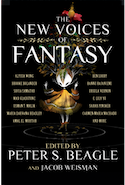
Looking at magic in unfamiliar ways, the emerging authors brought together in The New Voices of Fantasy (Tachyon) freshen up the genre’s much-sought sensawunda. Within these pages it’s everywhere: in amorous mobile skyscrapers, ravished tornado shelters, and blissfully ignorant anthropologists’ notebooks. Most effective are the tales of those whose difference could easily have disqualified them from inclusion in past authorial pantheons. The half-sulking, half-singing cadences of Sofia Samatar’s Hugo and Nebula Award-nominated “Selkie Stories Are for Losers” might not have made it into this newly formed canon because of her East African heritage, despite her academic status; the mazing reflections of Usman T. Malik’s British Fantasy Award-winner “The Pauper Prince and the Eucalyptus Jinn” might have been brutally trimmed back or eliminated altogether, their South Asian cultural currency disregarded as valueless. But we’re all so much the richer for the strange, beautiful wealth to be found throughout this entire book.
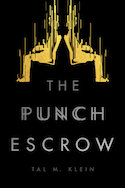
The Punch Escrow (Inkshares) by software marketer Tal Klein also affords a novice’s take on established SFFH tropes. As numerous YouTube videos and late-night TV hosts have pointed out, our Star Trekkian concept of teleportation basically boils down to a traveler’s duplication followed by their murder. In 1995 James Patrick Kelly addressed teleportation’s ethical dilemmas in his Hugo winning novelette "Think Like a Dinosaur"; Klein’s revisitation features a narrator whose day job is being a professional smartass and who lards the text with breezy, confident-sounding footnotes full of quantum foam and peeing mosquitoes. Good fun.

So what’s a new voice? What’s an old one? Is there anything in-between? Daniel H. Wilson, author of The Clockwork Dynasty, already has beaucoup books out, including the awesome Robopocalypse and its sequel, Robogenesis, and my personal nonfiction favorite, Where’s My Jetpack? Clockwork’s steampunky cover promises brass gears and leather and lots of them, and readers looking for the Retrofuturism typically associated with these trappings won’t be disappointed. Much of the book’s action takes place in 18th- and 19th-century Europe, with forays into modern times and also, interestingly, into the distant past of the Chinese empire. One of the novel’s two viewpoint characters is (this is not a spoiler, trust me) a robot created millennia ago by vanished supermen. Wilson’s academic expertise is robotics, enabling him to make his references to the spinning, metal-impregnated ceramics animating these Ur-androids’ somehow credible. According to him robots have been with us always. Though new, they’re incredibly old. A neat trick in perspective and a pleasing one.
Couple of upcoming cons
The self-proclaimed largest SFFH convention in the whole freakin universe, Dragon Con, is also home to the Dragon Awards. Like Worldcon’s Hugos, the Dragon Awards are recent victims of Puppy voting manipulation schemes. Unlike the Hugos, award categories include both comics and graphic novels, and four separate game varieties. This wide spectrum of choices reflects the literature-plus orientation of Dragon Con, with its weighty emphasis on movies, cosplay, and a myriad other ways to interface with the unknown.
Another large, multifarious SFFH shindig, Archon, has historically taken place in St. Louis, MO. Its occupancy of a hotel in Collinsville, IL likely has more to do with negotiated stay rates and facility availability than the travel advisory issued by the NAACP, but this is still a good opportunity to support a forty-year-old institution without validating its home state’s troublingly oppressive legislation. Plus Seanan McGuire tops this year’s list of Guests of Honor, and plenty of swoony pros are sure to attend among the approximately 2000 others showing up.
Future Alternative Past: Dividing past the dividing lines
Every month, Nisi Shawl presents us with news and updates from her perch overlooking the world of science-fiction, fantasy, and horror. You can also look through the archives of the column.
Subbasements
Some folks consign SFFH to the nether regions of literature. Never mind that the world’s earliest tales, whether duly recorded and or merely oft-repeated — Beowulf, The Story of Hong Gildong, The Blazing World, the Ramayana, and many others — can also easily be seen as fantasies, horror stories, and fictions based on then-current science. Modern speculative fiction, say these critics, is formulaic and predictable and totally unworthy of readers’ time and attention. Of course this bothers some of us.
Much like oppressed African Americans dividing themselves up according to skin color (if you’re ignorant of this phenomenon, read about the paper bag test), the SFFH community divides the genre into a hierarchy of smaller subgenres. Top of the heap depends on who you ask, but the cases for both the “literary” and “hard” versions of science fiction have their proponents.
Literary SF supposedly hews most closely to mainstream or “mimetic” literature’s values, which latter ostensibly focus on conveying consensus reality to its audience using conventional techniques. (Note that mimetic is the label applied to this sort of writing by nonmimeticists.) Calling a book such as John Crowley’s Engine Summer literary SF implies that it’s descriptive, character-centered, and pretty much plotless. Two out of three right.
The term “hard SF” is generally accepted to mean fiction which extrapolates from known science. But that’s not all there is to fitting into the hard SF category. For one thing, plenty of lists of this subgenre’s best books include those in which it’s possible to travel faster than the speed of light, such as the wonderful Use of Weapons by Iain M. Banks. Nothing we know now says that’s ever going to be possible. For another thing, what qualifies as science can be a little less inclusive than what’s covered by the dictionary definition. Physics is always good, ditto mathematics, astronomy, and chemistry. But biology will frequently be left out of the science category, with the lamentable result of lists excluding Nancy Kress’s thought-provoking “Beggars in Spain.” And don’t even ask about anthropology, sociology, or other “soft” disciplines.
One factor keeping writers out of the ranks of hard SF authors in the past was being born non-white and non-male. That’s changing, though there’s a lag effect due to previously published criticism.
Space opera, a subgenre of interstellar tales long associated and often overlapping with hard sf, has recently rebooted itself. So-called “New Space Opera” takes social justice concerns seriously, and seems to have attracted proportionately higher participation by women and people of color such as Gwyneth Jones), Vandana Singh, Ann Leckie, and Aliette de Bodard.
The popularity of subgenres is time-critical: for the moment, steampunk’s star has waned; stories of zombies, though the monsters of their premise are typically cold-blooded, are hot right now; cyberpunk’s flame burned bright at first, then flickered, then revived; dystopic and utopic fiction battle it out for supremacy on the virtual shelves of online retailers around the globe. Categories of SFFH both arise and die; Tobias Buckell’s Sly Mongoose owes much of its neo-pulp feel to the vanished subgenre of boys’ diving adventures.
People enjoy categorizing the world. Even if and when the SFFH community emerges from the literary basement we’ve been relegated to by some of taste’s arbiters, we insiders will probably see distinctions between more of our genre’s subgenres than outsiders could ever know or care about.
Recent books recently read
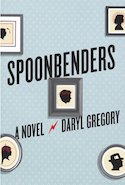
Spoonbenders (Knopf) is Daryl Gregory’s tenderly hilarious take on the dysfunctional family life of showbiz psychics. The publisher calls Spoonbenders “literary fiction.” But I’m going out on a limb here and saying that since Gregory has stated publicly that he doesn’t think distance viewing, precognition, or hands-off cutlery-mangling really happen, this book is some variety of SFFH. Chapters alternate viewpoints between a pot smoking, masturbating teen prone to out-of-body experiences; a crippled con artist; a human lie-detector; and a man whose tortured existence proves that a genuine ability to see the future would make obsessive compulsive personality disorder a picnic by comparison. The action alternates, too, switching between the scenes set in the 1960s and the summer of 1995. The plot involves revenge, with the inexplicable Rube Goldsbergesque machinations of precog Buddy providing a ticking time bomb, and the denouement a highly pleasurable explosion.
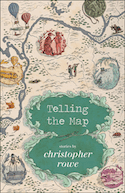
Though most of the stories in Christopher Rowe’s new collection Telling the Map are SF, its cover is reminiscent of Edward Gorey’s weirdly off-kilter illustrations for disturbingly dark children’s books. That cognitive dissonance is a perfect replication of Rowe’s style: in “The Border State,” long-awaited sequel to his acclaimed 2004 story “The Voluntary State,” Rowe pits hymn-singing, bicycle-racing teens against a nanotech-wielding rogue AI; in “Another Word for Map Is Faith,” earnest Christians remake the world in the image of holy maps — with deadly consequences. Delightfully strange, these ten stories transport readers to futures full of sentient cars pining for their owners, automated horses, and tomatoes grown to give blood transfusions — an odd and interesting and deceptively bucolic setting for the narration of some astonishing events.
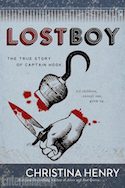
Peter Pan, fantasy’s favorite sociopath, is the villain of Christina Henry’s Lost Boy (Penguin). Subtitled The True Story of Captain Hook, this new novel follows the pattern Henry established in her earlier novels Alice and Red Queen, retelling a familiar tale from a wrenchingly different viewpoint. Hook, known here as Jamie, is revealed as Peter’s original playmate, brought to the magical island of Neverland as a boy; over a few days, first-person narration details his realization of Peter’s centuries-long betrayal. Much of the book’s content is non-canonical: giant spiders menace Jamie and his fellow Lost Boys, who arrive in Neverland via a tunnel rather than flying there. Fairies and fairy dust are unheard of. Sweat and dirt and blood are sprinkled liberally throughout the pages. Still, elements of the story are predictable, and the author’s fast pacing can’t keep those — and the ending — from being absolutely no surprise.
A few upcoming not-cons
I’m Armadillocon 39’s Guest of Honor, which means I’ll do a reading, give a speech, lead a workshop, participate in panels, and eavesdrop on panels about my writing. And lend an air of grace and credibility to the overall proceedings, I hope. Of course I encourage you to attend; besides my presence and the others listed officially on the con’s site, I happen to have heard that you’ll be blessed with appearances by Joe R. Lansdale, Chris Brown), and L. Timmel Duchamp. Yes, it’s in Texas. But Austin, okay?
Not all the cool kids are coming to Armadillocon, though, because Worldcon, the 75th World Science Fiction Convention, takes place in Helsinki the very next week. Sure it’d be great to do both, but I’m not. Though I wish I could. Worldcon’s GOHs include Nalo Hopkinson and Tiptree Award winner Johanna Sinisalo. Plus it’s in Finland, which is probably quite a bit more hospitable in August than Texas, temperature-wise. Just remember not to feed the trolls.
Future Alternative Past: Dead(ish)
Every month, Nisi Shawl presents us with news and updates from her perch overlooking the world of science fiction, fantasy, and horror. You can also look through the archives of the column.
Live long and prosper
Last night I dreamed, prosaically, that I was conversing with my oldest niece. My half-sobs kept trembling up to disturb the surface of our conversation; I excused myself to her by saying how much she looked like her mother, my baby sister, dead now four years. Then I woke, realizing that the face and voice I’d been talking with didn’t merely resemble my sister’s, they were my sister’s, back when she was young, vibrant, beautiful, cancer-free. Alive.
So there you have two forms of immortality: survival via remembrance and via genetic legacy. But this has never been enough for the bulk of us. Like religion, SFFH has sought for centuries to address that lack. Beginning with Mary Shelley’s 1818 novel Frankenstein, continuing through George Eliot’s 1859 novella “The Lifted Veil” and beyond, the fantastic genres have consistently questioned the supposed impenetrability of the barrier between life and death. Which you would naturally expect from ghostly tales of haunted mirrors and clairvoyant ascetics and so forth, but sometimes science and technology get dragged into the fray.
“Corpsicles,” as they’re facetiously referred to, are one example of sfnal immortality made (perhaps prematurely) real. The thought is that frozen people — whole bodies, or, less expensively, just their heads — will be thawed and restored to life decades after they’ve died. Though Walt Disney was an early supporter of human cryogenics, he didn’t get himself frozen, (let alone become the first corpsicle, as is often rumored). That honor goes to Dr. James Bedford, whose body, after his death in 1967, was cooled to a temperature of minus 79 centigrade and is now stored at Alcor Life Extension's Arizona facilities.
The answers to moral, technical, and other questions rising from the practice of cryogenic suspension — Would revived corpsicles have legal rights? What would motivate their resuscitation? Who could be held responsible in the case of accidental thawing? — are explored by quite a few SFFH authors. In addition to those listed in the linked articles I recommend Tanith Lee’s novelette “The Thaw.”
Another favorite sfnal way to cheat death is to upload one’s memories and/or consciousness into another living being’s brain or, more typically, into a computer. In Octavia E. Butler’s Wild Seed, her villain Imaro does the first at will; he couldn’t care less that his head-hopping dislodges and kills a body’s original tenant. James Patrick Kelly’s “Think Like a Dinosaur” examines a problem that develops when transferring consciousness to artificially created bodies. William Gibson and most cyberpunk authors opt for the machine upload scenario, and of course ethical quandaries can be involved there as well, as readers of my Making Amends series (“The Mighty Phin” et al.) are aware.
The aforementioned Gibson famously said: “The future is already here — it's just not very evenly distributed.” Which may well be the truth when it comes to a third form of sfnal immortality: medical advances. Already we have a sharp disparity in average life expectancies due to the availability of insurance and the quality of care afforded the rich as opposed to the poor. Already we have toilets that monitor urine flow and analyze hormone secretion. Bruce Sterling’s 1996 novel Holy Fire) extrapolates these points out to a time when his protagonist shops for an affordable, reliable life extension treatment. Never mind the excruciating pain she must subject herself to — this is a largely financial decision. Also one on which market forces, planned and unplanned obsolescence, and general demographics come to bear.
Recent books recently read
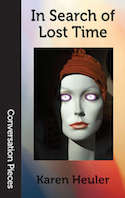
Despite In Search of Lost Time’s (Aqueduct) omnipresent cancer treatment medtech, this standalone novella resonates less with the hard science stylings of cryogenics, uploads, and gene-tailoring than it does with the happily-ever-after limbo at the end of fairytales. Author Karen Heuler’s heroine Hildy discovers that chemo infusions targeting malignant lesions on her “tempora” — an imaginary area of the brain — allow her to see, manipulate, and ultimately steal other people’s time. Her superpowers neither free nor cure Hildy, though. Instead, she struggles to integrate them into a humane and principled philosophy while fending off the self-interested alliances of warring would-be time-mongers. She girds herself for battle in red-heeled boots, silk head scarves, and penciled-on eyebrows, but kindness and self-reflection prove to be her most kickass weapons.

Firebrand (Tor Teen) is A.J. Hartley’s second novel set in Bar-Selehm, a gritty, steampunk analogue of South Africa. Steeplejack introduced readers to Anglet Sutonga, who began the book as an impoverished young laborer among Bar-Selehm’s chimneyed rooftops and ended it hired by her government’s main opposition party as a spy. Now Sutonga, member of a racial minority distinct from the region’s ruling whites and indigenous blacks, becomes entangled in a plot involving smuggled war refugees and stolen blueprints for a deadly machine gun. With her usual flair for leaping headfirst into trouble and sorting out the consequences later, she takes on a psychopathic assassin, a supernatural legend come to haunting life, and a hate-spewing white supremacist in her pursuit of truth and at least an approximation of justice. The results satisfied both my cautious mind and my crusading heart.
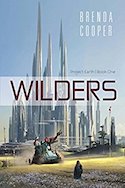
Seattle-area Futurist Brenda Cooper’s Wilders (Pyr) is the first volume in her new Project Earth series. The premise is promising: megacities house most of North America’s population, with the surrounding land slated for “re-wilding,” a sort of remediation-cum-restoration project. Our entry point into this near-future scenario, though, is the somewhat feckless Coryn Williams, whose older sister Lou strikes out on her own as soon as she can to do cool stuff like reintroduce wolves to the prairie. Coryn, abandoned, must stay a couple of years after that in the milieu that mysteriously led their parents to kill themselves — there’s a paragraph on possible reasons for their suicide on page 196, but by then Coryn has achieved adulthood and set off with her robot companion to track Lou down. Revolt among non-city dwellers and deception among city rulers make for a gloriously unpredictable denouement and hold out hope for more action in the rest of the series.
Couple of upcoming cons
Westercon is your prototypical large regional science fiction convention. Past iterations — all taking place, per the organization’s website, “west of the 104th meridian” — have featured art shows, filking (fannish folk music), and everything else con-goers have come to expect from full-service conventions. This is its 70th year of meeting those expectations.
But wait — do you like SFFH books more than the genre’s movies, cosplay, games, and such? Then Readercon is your cup of vodka. Two tracks of panels talking about books and one room of dealers selling them. That’s it for programming. Authors are the only Guests of Honor — two living and one dead per year — plus a plethora of guests of no particular honor but plenty of literary distinction, like Samuel R. Delany, Kit Reed, and Jonathan Lethem.
Future Alternative Past: hope for the ecospec-future
Every month, Nisi Shawl presents us with news and updates from her perch overlooking the world of science-fiction, fantasy, and horror. You can also look through the archives of the column.
Wednesday, May 3 — last night as I begin to write this — Annie Proulx gave a talk to the University of Washington’s librarians about global deforestation. It’s the topic of her most recent novel, Barkskins, a non-genre account of lumbering’s three hundred years of greed and waste. She knew whereof she spoke. But unlike fellow octogenarian Ursula K. Le Guin giving her famed National Book Award remarks, Proulx did not send chills up and down her audience’s spines. We had to listen carefully to hear her small, hesitant voice as she told us how she’d gathered beechnuts in the woods of New England as a child. “You can’t do that now. Those places are gone.” Difficult to digest that truth. Quietly, more unpalatable facts followed: the impact of hunting on carbon sequestering hardwoods, the reasons behind scientists’ agreement that we’re now living in a sad new Age called the Anthropocene, an era of high human impact on the biosphere.
Her topic’s emotional freight seemed almost too heavy for Proulx herself to carry: the speech ended abruptly, and I overheard her confessing to one of the inevitable cluster of admirers afterwards that she wished she could have continued. Maybe it really is too much for any individual to bear — the knowledge that we’re destroying our own habitat.
Pushing my way through the librarians and donors surrounding her — did I mention this event was a fundraiser? It was — I put in Proulx’s hand something she was in no position to offer me: hope. Specifically, I gave her a postcard for an anthology called Sunvault, a book of “solarpunk” stories postulating a future in which we overcome our species’ doom. Solarpunk, aka “ecospec,” aka “cli-fi,” is a subgenre of SFFH confronting the looming threats of melting ice caps, rapidly rising oceans, monster storms, and the thousand other slings and arrows of climatic catastrophe. Think Tobias Buckell’s Arctic Rising and Hurricane Fever, or more recently Kim Stanley Robinson’s New York 2140, which I reviewed here briefly last month.
It’s not that the authors of ecospec deny climate change’s existence or impact (though I do know of one major SFFH publisher who enforces an outright ban on stories dealing with it). It’s just that that’s not where we stop. It’s where we begin.
Where do we go from there? How do we get to somewhere better? Depends on the writer. Fictional fixes applied to unsustainability can be technological or magical or political or any combination of the three; they can come from alternate timelines or aliens or marginalized humans, the forgotten past or the distant future. In addition to fixes there are adjustments: do we change our environment or change ourselves?
The answer, of course, is both. You get great ideas for doing the former and mental practice doing the latter when reading and writing cli-fi (or whatever else you want to call it; futurist Brenda Cooper, author of the forthcoming cli-fi novel Wilders loathes that particular term for what she writes). Proulx’s earliest published stories were SFFH. Maybe she’ll wend her way back to the genre and lay her burden down.
A few upcoming not-cons
Held annually here in Seattle, the Locus Awards Weekend isn’t exactly a con. There are panels, but usually no more than four. Readings, but only one. Parties, but just two. The main attraction is the Saturday afternoon lunch-cum-awards ceremony, emceed by the mighty Connie Willis with kibitzing from the indefatigable Nancy Kress. In honor of Locus magazine’s deceased founder Charles N. Brown’s sartorial preferences, Hawai’ian shirts are de rigueur — the gaudier and less authentically Hawai’ian the better. And though Locus is a serious publication (it’s basically the trade organ for English language SFFH), and the Locus Awards are serious awards, the ceremony itself is rather silly, with attendees vying for plastic bananas and novelty-store fake-grass Hula skirts.
Another not-con, NubiaOne Fest, will take place at a library in Auburn, Georgia over the evening June 16 and the afternoon of June 17. Figuring aficionados of Afrodiasporic SFFH would need something to tide us over between State of Black Science Fiction 2016 and SoBSF 2018, Milton Davis and Balogun Ojetade pulled together a sampling of their larger events’ programming, with participation from visual artist John Jennings, fellow authors Valjeanne Jeffers and Jeff Carroll, and others.
Now in its third year, The Brass Screw Confederacy proudly proclaims on its website that it “ain’t no Con.” A steampunk performance festival seems more like the proper description. Taking advantage of Port Townsend’s Victorian seaport architecture, costumed participants attend period-appropriate self-defense classes, play Tactical Croquet, and enjoy specially staged musical acts such as Frenchy and the Punk.
Recent books recently read
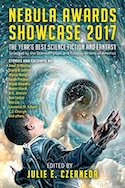
At least as prestigious as the Locus Awards, the Science Fiction Writers of America’s Nebula Awards will be presented May 19. Full disclosure ‐ my debut novel Everfair is on the final ballot. (AAAAAAA!!!!!) So with much personal interest I read the anthology commemorating last year’s contenders, Nebula Awards Showcase 2017 (Pyr). The field is overflowing these days with year’s best anthologies whose contents are chosen by experienced and renowned short fiction editors, but this is the only selection mandated by an entire organization’s membership. Surprisingly, the results don’t bite.
It’s an honor just to be nominated, and in addition to the winning short story, five other finalists in that category appear in their entirety. This is a boon to those of us who haven’t managed to hunt them all down. Here we have a chance to catch up on what professional SFFH authors believe is the genre’s forefront.
But this book’s pages aren’t infinite. Poems and longer works are represented only by their categories’ winners (poems, novelettes, and novellas) or by excerpts (novels). In the case of the new Damon Knight Grand Master C.J.Cherryh, who has written over 60 novels, we must content ourselves with excerpts from only two. Which could be sad-making. But add essays on other recipients and lists of honorees since the Nebula Award’s inception in 1965, and you have a complete yet handy-sized cross-section of SFFH’s most recent fruitings.
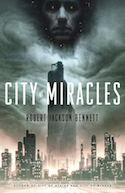
City of Miracles (Broadway Books) concludes multiple award-winner Robert Jackson Bennett’s Divine Cities trilogy. The series starts with the premise of magic as a tool of oppression: generations after the powerful gods which white, slave-owning “Continentals” worship get gunned down by a brown-skinned revolutionary, the pantheon’s occult legacies and byblows still cause the rebels’ new government trouble. Returning to Bulikov, setting of the first book, City of Stairs, Bennett leads readers through an astounding landscape: war-ravaged, partially restored, and lurching unsteadily into the future. Former enforcer Sigrud je Harkvaldsson deserts the seclusion of this fantasy world’s northern forests to investigate the assassination of his only friend, Minister Ashara Komayd. Is there Divine involvement? The presence of a toxic pocket universe say yes. Harkvaldsson survives entry and exit unfazed. He goes on to face down intimate truths and torturers with grim, love-steeped dedication; his painful eventual triumph is depicted with wit, restraint, and all Bennett’s artless-seeming art.